






…from Ashland to Paducah, 3.9 million Kentuckians benefit from the Honorable Order of Kentucky Colonels’ Good Works Program. Children, veterans, people with disabilities, the hungry, and the homeless all find help through the services of 314 nonprofits receiving grants from us this year. And we committed over $4.5 million to tornado and flood relief across the state.
A commission as a Kentucky Colonel is the highest civilian honor a Kentucky governor can bestow. And many Colonels consider annual or monthly contributions to the Honorable Order to be a continuation of the altruistic activity that earned them that commission.
If you are a Kentucky Colonel, please consider a contribution to the Good Works Program. Call us, or visit KyColonels.org, today.

16

A Mayfield resident realized a dream by starting a DIY blog that has evolved into a multimillion-dollar business 22 Log and Stone Getaway A stay in a Kentucky cabin takes the visitor back to the days of the pioneers or Depression-era laborers—and away from the noise of modern life 28
A year after the devastating tornadoes that struck western Kentucky, Dawson Springs residents remember that fateful night and look to the future
A Santa Claus performer connected with tornado victims—and with the late, beloved singersongwriter who put Muhlenberg County on the map

36
The lifelong friendship of Rosemary Clooney and Blanche Chambers defied the segregationist conventions of their youth
40 Frontier Odyssey The Jenny Wiley saga, with its tangle of facts and folklore, has intrigued audiences for more than 200 years
Test your knowledge of our beloved Commonwealth. To find out how you fared, see the bottom of Vested Interest.
1. In the 1954 classic film White Christmas, Maysville’s Rosemary Clooney and Cincinnati’s VeraEllen perform as which fictional sister duo?
A. The Pointer Sisters
B. The Wallace Sisters
C. The Haynes Sisters
2. Included on Barbra Streisand’s A Christmas Album (1967), “I Wonder as I Wander” is a Christmas carol written by which noted Kentucky folklorist and musician?
A. John Jacob Niles
B. Mary Travers
C. Jean Ritchie
3. Which Kentucky-born actress played Olivia Walton in The Homecoming: A Christmas Story (1971), the predecessor to the popular 1970s television series The Waltons?
A. Florence Henderson
B. Patricia Neal
C. Irene Dunne
4. Past Poet Laureate George Ella Lyon, editor of A Kentucky Christmas (2003) and writer of “A Christmas Feast” monologue (1990), met her husband, Stephen, at which Kentucky school?
A. Transylvania University
B. Asbur y University
C. Centre College
5. Haven Gillespie, who wrote “Santa Claus Is Coming to Town,” was born in which northern Kentucky city?
A. Newport
B. Covington
C. Rabbit Hash
6. Which Henry County town, best known for its living nativity scene, offers a special postmark during the Christmas season, drawing people from surrounding counties and other states?
A. Bethlehem B. Santa Claus
C. Nor th Pole
7. Folk singer Jean Ritchie’s 1959 album Carols for All Seasons includes the only American translation of the standard “I Saw Three Ships” as well as “Christ Was Born in Bethlehem” and “Cherry Tree of the Cumberlands.”
Remembered mainly for her solo work, Ritchie was the youngest of 14 children, 10 of whom were sent to college by her parents. In 1952, she earned which scholarship that enabled her to study the connections between Appalachian music and folk tunes in England, Ireland and Scotland?
A. McDougle
B. Fulbright C. Academy of the Performing Arts
8. During John Hunt Morgan’s “Christmas Raid,” his men destroyed everything they could along a 35-mile stretch of the Louisville and Nashville Railroad near which Bullitt County town?
A. Mount Washington B. Shepherdsville C. Lebanon Junction
9. Lexington actor Ralph Wesley Foody appeared in the film within the film Home Alone, where he said which famous catchphrase?
A. “God bless us, everyone.”
B. “You’ll shoot your eye out.” C. “Keep the change, ya filthy animal.”
10. Of the half-dozen Ernest P. Worrell movies starring Lexington native Jim Varney, Ernest Saves Christmas was the highest grossing. Varney’s most successful franchise was the Toy Story movies, in which he plays which recurring character?
A. Buzz Lightyear B. Slinky Dog C. Hamm, the piggy bank
© 2022, Vested Interest Publications
Volume Twenty-Five, Issue 10, December 2022/January 2023
Publisher + Editor-in-Chief
Editorial
Patricia Ranft Associate Editor
Rebecca Redding Creative Director
Deborah Kohl Kremer Assistant Editor
Ted Sloan Contributing Editor
Cait A. Smith Copy Editor
Jackie Hollenkamp Bentley, Jack Brammer, Bill Ellis, Steve Flairty, Gary Garth, Mick Jeffries, Kim Kobersmith, Brigitte Prather, Walt Reichert, Tracey Teo, Janine Washle and Gary P. West
Business and Circulation
Barbara Kay Vest Business Manager
Jocelyn Roper Circulation Specialist
Lindsey Collins Senior Account Executive and Coordinator
Kelley Burchell Account Executive
Teresa Revlett Account Executive
For advertising information, call 888.329.0053 or 502.227.0053
KENTUCKY MONTHLY (ISSN 1542-0507) is published 10 times per year (monthly with combined December/ January and June/July issues) for $20 per year by Vested Interest Publications, Inc., 100 Consumer Lane, Frankfort, KY 40601. Periodicals Postage Paid at Frankfort, KY and at additional mailing offices.
POSTMASTER: Send address changes to KENTUCKY MONTHLY, P.O. Box 559, Frankfort, KY 40602-0559. Vested Interest Publications: Stephen M. Vest, president; Patricia Ranft, vice president; Barbara Kay Vest, secretary/treasurer. Board of directors: James W. Adams Jr., Dr. Gene Burch, Gregory N. Carnes, Barbara and Pete Chiericozzi, Kellee Dicks, Maj. Jack E. Dixon, Bruce and Peggy Dungan, Mary and Michael Embry, Thomas L. Hall, Judy M. Harris, Greg and Carrie Hawkins, Jan and John Higginbotham, Frank Martin, Bill Noel, Michelle Jenson McDonnell, Walter B. Norris, Kasia Pater, Dr. Mary Jo Ratliff, Barry A. Royalty, Randy and Rebecca Sandell, Kendall Carr Shelton and Ted M. Sloan.
Kentucky Monthly invites queries but accepts no responsibility for unsolicited material; submissions will not be returned.

Counties mentioned in this issue...
I read Steve Vest’s tribute to his beloved Toby (November issue, page 64).

As an animal lover, I can appreciate his love for the little fella. Toby sounds special.
Erv Klein, LouisvilleHow pleased and pleasantly surprised I was to open my November issue of Kentucky Monthly and find Abby Laub’s article and photos about the all-female Kentucky Honor Flight visit to the nation’s capital (page 12).
I am a retired navy commander (22 years) and currently work at the Women in Military Service for America Memorial, also known as the Military Women’s Memorial (MWM), which was one of the stops by this Honor Flight. We were honored to have this all-female veterans group from Kentucky visit us. Their stories are profound,
moving. Some are sweet and funny; all are important.
Our mission at the memorial is threefold: 1) to recognize, acknowledge and honor all women who have ever served in the United States Armed Forces from the American Revolution to those currently on active duty; 2) to collect the stories from every female veteran and add their stories to our database register; and 3) to educate the general public about the collective history of military women’s contribution, service and sacrifice.
Women tend to downplay their military service, and we make a point to emphasize that their service and stories are important and deserve recognition and acknowledgment. That is why the Military Women’s Memorial is so important.
To find out more information on how to register a story (by the servicewoman or by
family/friends of a servicewoman) please visit the website: womensmemorial.org Help us to fulfill our mission to honor all women who have served or are currently serving. And we look forward to many more Honor Flight visits from Kentucky!
Jan Fitzsimmons, MWM Volunteer Coordinator, Arlington, Virginia
I am impressed with the talent of actors from Kentucky (Past Tense/ Present Tense, November issue, page 58).
I was never a fan of Victor Mature, but I did see The Robe and Samson and Delilah. Both were good movies. I have seen a bunch of George Clooney movies and enjoyed them, but I think Patricia Neal is way up there on my list.
I think Johnny Depp does a good job, but he creeps me out! Patricia Neal wins.
Ann Cohen, via email
We Love to Hear from You! Kentucky Monthly welcomes letters from all readers. Email us your comments at editor@kentuckymonthly.com, send a letter through our website at kentuckymonthly.com, or message us on Facebook. Letters may be edited for clarification and brevity.

Kentucky Monthly’s annual gift guide highlights some of the finest handcrafted gifts and treats our Commonwealth has to offer.
This handy guide to sipping in the Bluegrass State spotlights local breweries, wineries and, of course, distilleries. Discover unique ways to drink in Kentucky, creative cocktail recipes and more.
Take a copy of the magazine with you and get snapping! Send your high-resolution photos (usually 1 MB or higher) to editor@kentuckymonthly.com or visit kentuckymonthly.com to submit your photo.
Even when you’re far away, you can take the spirit of your Kentucky home with you. And when you do, we want to see it!
FLORIDA
Dave and Dorothy Higdon Jett of Louisville enjoyed a sunny trip to Saint George Island, Florida, with their family.
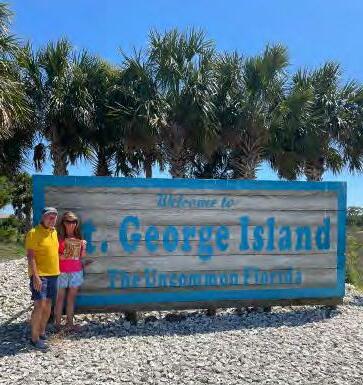
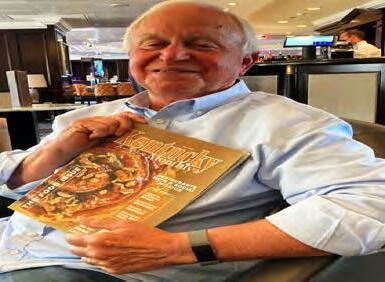
PORTUGAL (right)
Louisville residents Terry and Suzanne Zoeller visited the Castle of Castelo Rodrigo while on a river cruise through Portugal and the Douro River Valley.

SPAIN ( left)
Rick and Carol DuBose of Bowling Green toured Spain, Portugal, France and England via cruise ship. Rick is pictured on board the Oceania ship Sirena off the coast of Spain.
Carolyn and Bob Rainey of Louisville are pictured in front of the Fontaine de la Rotonde on the tree-lined Cours Mirabeau in Aix-en-Provence, France. The couple celebrated their 50th anniversary with their family in Aix-en-Provence, where one of their daughters lives.
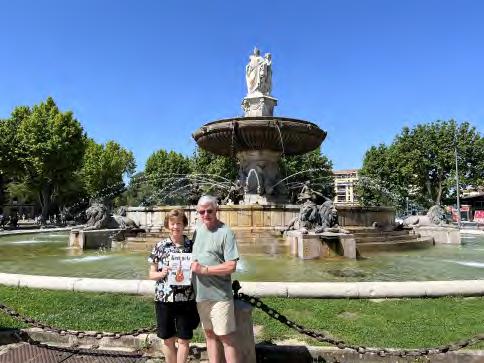
WYOMING ( left)
Madisonville residents Patricia Hawkins and Rick Hovis visited Jackson, Wyoming, and celebrated their 30th wedding anniversary in Grand Teton National Park.

(right)
Rick and Diane Lawson of Prospect traveled to the University of Cambridge in Cambridge, England, where their son, Parker, received a doctorate from the university’s Selwyn College.
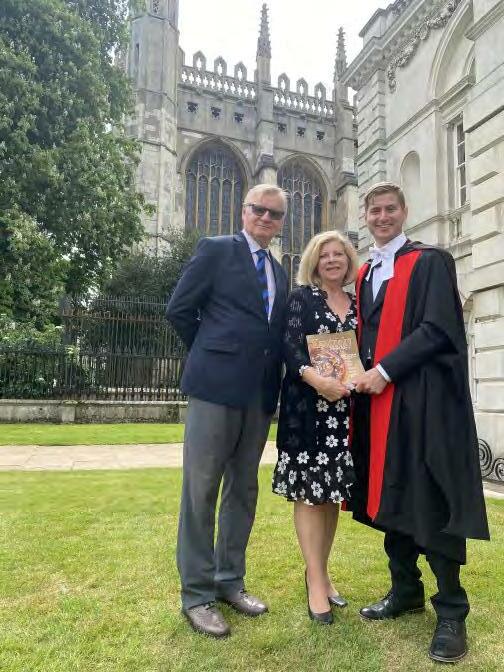
FLORIDA ( left)
Louisville couple Steve and Lisa Yankowy vacationed at Perdido Key in the far northwest part of Florida’s panhandle.

HAWAII ( left)
Sandy Chatelain and family, from Louisville and Lexington, visited Ka’eleku Caverns in Maui, Hawaii, while traveling the scenic Road to Hana. On a self-guided tour, they used flashlights to explore a lava tube—a passageway formed from hot flowing lava.
Jean Wheatley of Murray celebrated her birthday by visiting Alaska on a cruise with the Lanes of Brentwood, Tennessee. Pictured with Jean are her grandson, Andrew (holding Kentucky Monthly), daughter Catherine, grandson Clayton, and son-in-law Arthur


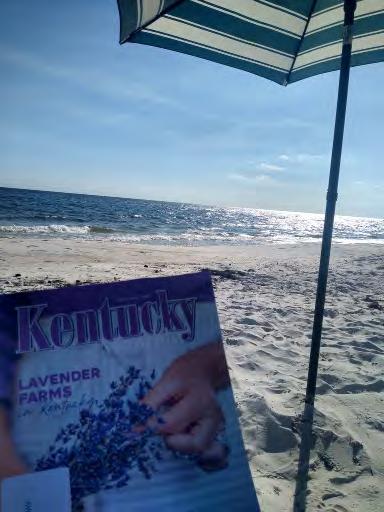
FLORIDA (right)
Louisville resident Terri LenahanDowns relaxed on Mexico Beach, aka ‘The Forgotten Coast.”

SCOTLAND (left)
While on a trip to Scotland, Becky Skaggs of Paintsville and her daughter Jessie Skaggs, who lives in Louisville, toured the Johnstons of Elgin Mill, which crafts some of the finest cashmere fabrics in the world.

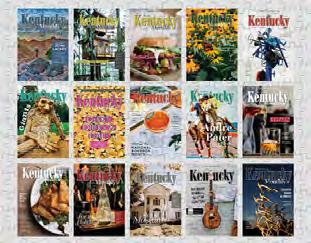


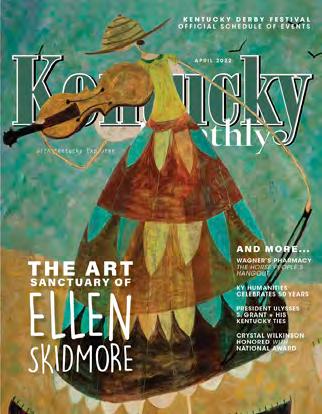
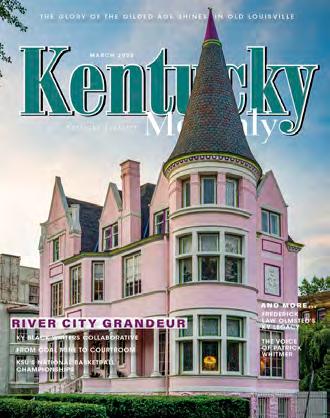




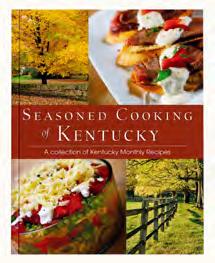


THE WORLD’S LARGEST MURAL OF SECRETARIAT was unveiled in a public dedication on Nov. 19 in Paris. Gracing the side of the historic Baldwin Hotel on Main Street, the threestory mural—painted by eastern Kentucky artist Jaime Corum—is the first phase of the Secretariat Park Project, which will include landscaped green space with decorative benches and accent lighting. A life-size bronze sculpture of the 1973 Triple Crown winner will serve as the centerpiece of the park, scheduled to open in November 2023.

The University of the Cumberlands in Williamsburg has dedicated a collection of historical papers belonging to the late Bert T. Combs, who served as governor of the Commonwealth from 1959-1963. Along with a bronze bust of Combs, the papers are housed in the university’s Grover M. Hermann Library.
“{Combs’] vision transformed state education, while other states followed this reform,” Cumberlands President Dr. Larry Cockrum said at the dedication. “Roads developed under his administration created jobs and provided access to remote areas … Gov. Combs had a tremendous impact on the lives of all Kentuckians, and we are honored to be part of his legacy.”
A native of Manchester, Combs attended what was then Cumberland College in the late 1920s before obtaining a law degree from the University of Kentucky.
The University of the Cumberlands previously had established the Bert T. Combs Scholarship to help qualified Kentucky students meet full-tuition costs by making up the financial difference between tuition expenses and the students’ federal, state, KEES and merit scholarships.
The Bert Combs Papers can be accessed during library hours. For more information, visit ucumberlands.edu/library.
Twelve-year-old Brayden Locher of Owensboro became the 2022 FirstEnergy AllAmerican Soap Box Derby Rally Stock World Champion in Akron, Ohio, in July, capping off a stellar season in which he scored 30 wins. The Rally Stock is one of seven divisions in the championships.

Boys and girls ages 7-20 race their gravitypowered vehicles in local competitions around the country to gain points to qualify for the championships. To qualify, a racer needs 600 points. Brayden had 1,142 heading into the championships, ranking second overall in number of points.
Along with a trophy, Brayden received a $3,000 college scholarship and a world championship ring.
2 Mac King (1959), Hopkinsvilleborn magician with a residence at Harrah’s Las Vegas
3 Katie George (1974), Miss Kentucky USA 2015 from Louisville, now a sideline reporter for national sporting events
7 Martha Layne Collins (1936), governor of Kentucky from 1983-87
7 Jennifer Leann Carpenter (1979), Louisville-born actress best known for Dexter (2006-13)
18 Josh Dallas (1978), Louisvilleborn actor known for Once Upon a Time and Manifest
22 Diane Sawyer (1945), Glasgowborn journalist and television show host
28 John Y. Brown Jr. (1933), governor of Kentucky from 1979-83
30 Trish Suhr (1974), Middlesboroborn comedian best known as the “Yard Sale Diva” on the Style Network’s Clean House
2 Bryson Tiller (1993), singer/rapper from Louisville
4 Patty Loveless (1957), member of the Grand Ole Opry from Elkhorn City
7 Rand Paul (1963), United States Senator from Bowling Green
8 Crystal Gayle (1951), Grammy Award-winning singer from Paintsville
13 Nick Clooney (1934), newscaster, historian and television host from Augusta
14 Emayatzy Corinealdi (1980), Fort Knox-born actress best known for 2012’s Middle of Nowhere
16 John Carpenter (1948), Bowling Green film producer and director
20 John Michael Montgomery (1965), country music singer from Nicholasville
22 Terry Meiners (1957), radio personality from Louisville
25 Angie Gregory (1975), Paducahborn actress/writer




Kelsey Waldon knew from a young age that music was in her blood, and making music was going to be her life’s work. Getting there, though, took some determination.
Waldon, who lives in Nashville and tours internationally, plays country music in the same vein as Chris Stapleton and Sturgill Simpson. In a genre where people sometimes emulate having a rural background, Waldon’s credentials are real. Her western Kentucky accent and upbringing in Monkey’s Eyebrow attest to her authenticity. “Kentucky has so many different regions and beautiful pockets,” Waldon said. “[Plus], we gave the world Merle Travis and Bill Monroe.”
Waldon appreciated growing up in a country setting but said her hometown on the Ohio River frequently flooded. “We were river rats,” she said. She suspects many Kentuckians aren’t familiar with her often-swampy home environment. Her father still farms and runs a hunting lodge in Ballard County.
The maternal side of Waldon’s family was full of musicians. Her great-grandmother played guitar. Her grandmother also played guitar and wrote songs, and Waldon’s early musical memories involve her grandmother’s house. “I heard country music for the first time from her sunroom,” she said. “She had eight-track tapes of country and bluegrass all around.”
By the time Waldon started at Ballard Memorial High School, she was broadening her musical tastes. “I started writing songs like Bob Dylan, the Beatles, Neil Young.” The first three vinyl records she bought on her own were by Led Zeppelin, Pink Floyd and John Prine. Waldon said it was Prine’s music that opened a new musical world for her. “It was country and relevant,” she said.
While Dylan’s lyrics were an epiphany for her, Prine’s hit closer to home. “Oh, this is in my voice,” she said. “My standard for lyrics changed. [Prine] was one of the reasons I moved to Nashville. I heard you could see him hanging out.”
After graduation, Waldon moved to Nashville. She had her mother’s permission but also the understanding that she had to make it on her own. Waldon said she was too young to play in the bars and had to work 50-plus hours a week at a Target to make ends meet. Eventually, she moved back home, earned an associate’s degree at West Kentucky Community and Technical College, and returned to Nashville, when she was accepted into Belmont University’s prestigious music writing program. “I started to be with people who cared as much about songwriting as I did,” she said.
Waldon has lived in Nashville since 2012 and has been steadily getting more recognition for her work. Her album I’ve Got a Way was among the Top 10 Favorite Albums of 2016 from Ken Tucker of NPR’s Fresh Air. The single “All By Myself” made NPR’s Top 100 Songs list that same year. Her song “Kentucky, 1988” made Rolling Stone’s 25 Best Country and Americana Songs list in 2019.
It was in 2019 that Waldon had a night at the Grand Ole Opry that she still relives. “It was a pretty epic Opry night,” she said. While playing on stage with a band that included Sturgill Simpson, Prine asked Waldon to join his Oh Boy Records label. She was the first artist to be signed to the label in 15 years. “Joining Oh Boy has been like a dream. They are a dying breed in this industry,” she said. “I actually got to know John, and he was my friend. He was a mentor and a hero.” His passing from COVID-19 in April 2020 hit Waldon hard.

The pandemic slowed down Waldon’s career, as it did for most working musicians. She said that, in retrospect, there was good in the lockdown. She had time to write songs and release a new album.
Waldon is back on the road now, crisscrossing the country and promoting her newest album No Regular Dog. It’s a life she plans to continue. She loves making music and making connections with her audience, and that’s all she’s ever wanted to do. “I’m in for the long haul,” Waldon said. “I’m a lifer. I didn’t really have a Plan B.”
For information on Kelsey Waldon’s upcoming concerts, visit kelseywaldon.com

Kentucky Monthly's annual recipe contest is back following a pandemic-induced hiatus. Submit your favorite original recipe for a chance to win great prizes and see your dish featured in our May issue.

Frigid and sometimes blustery weather can result in a longing for warm hearty food.
Some studies have shown that, although we may spend most of the winter months in climatecontrolled settings, our bodies instinctively crave more sustenance. These dishes, with recipes provided by a selection of Kentucky chefs, can help keep you toasty and satisfied.
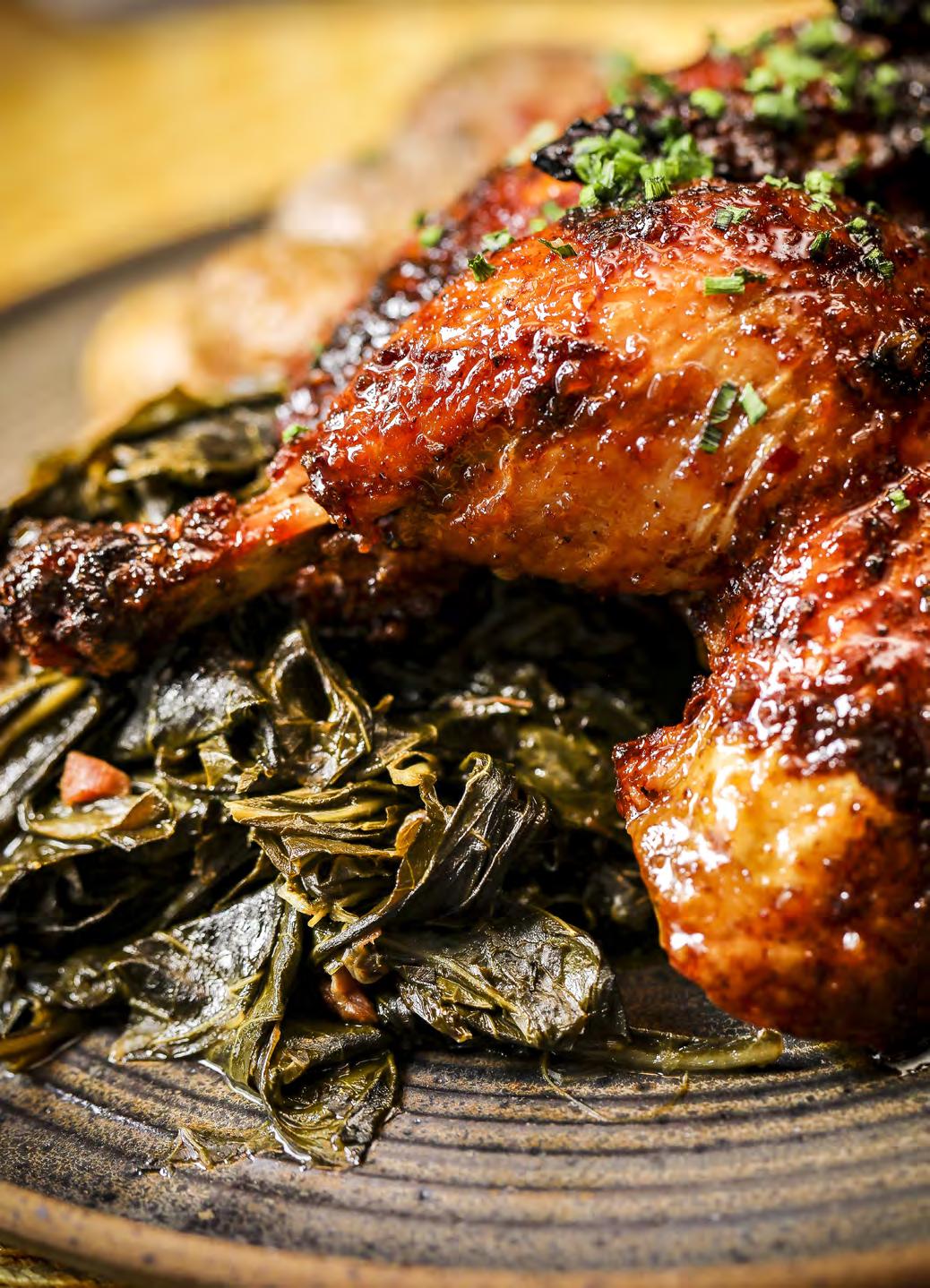

Courtesy of Everyday Kitchen, Louisville
½ Rivercrest Farm whole chicken
Angel’s Envy Bourbon glaze (recipe follows)
1-2 bunches collard greens
2 3D Valley Farm ham hocks
Salt and pepper
Water
1 pound baby potatoes
Olive oil
Red wine vinegar, apple cider vinegar, or vinegar of your choice
Garlic oil
1. Roast the chicken in the oven at 350 degrees until fully cooked, approximately 30-40 minutes. Or, if available, roast chicken over a flame spit for 90 minutes.
2. Lacquer with bourbon glaze and repeat every few minutes. Roast over a flame on your grill or a on grill pan over high heat until a nice char forms on the outside. Finish chicken with a final brush of glaze once it is plated.
3. Braise collard greens with ham hocks, salt, pepper and water for 2-3 hours, until greens are completely broken down. Drain off liquid and remove ham bones. Toss with vinegar of choice and finish with a pinch of salt.
4. Toss the potatoes with olive oil, salt and pepper, then roast at 425 degrees for 20-30 minutes until cooked through. Finish with a quick char on the grill or in a grill pan, and then toss with salt, pepper and garlic oil.
Everyday Kitchen sources local ingredients from
Rivercrest Farm (in Prospect, rivercrest.farm), 3D Valley Farm (southern Indiana, 3dvalleyfarm.com) and Angel’s Envy bourbon (Louisville, angelsenvy.com).
1 cup Angel’s Envy Bourbon
¾ cup brown sugar
3 tablespoons Dijon mustard
1 tablespoon Worcestershire sauce
1 clove garlic, minced
1 tablespoon minced fresh ginger
1½ tablespoons honey
2 teaspoons apple cider vinegar
2 teaspoons Kosher salt
1 teaspoon red pepper flake
1. Add all ingredients to a saucepan over medium heat. Simmer the mixture, stirring frequently until sugar dissolves completely.
2. Reduce heat and continue to gently simmer without whisking for 12-15 minutes. Allow to cool before using.
FOR SHRIMP BROTH:
1 yellow onion, halved with skin on
1 green bell pepper, halved
2 inches ginger root, washed and cut into coins
1 tablespoon black peppercorn
1 tablespoon soy sauce
4 bay leaves
1 tablespoon Crystal hot sauce (or other brand of choice)
2 cups shrimp shells and heads
4 cups water
1. In a stockpot, combine all ingredients except the shrimp shells and heads and bring to a rolling boil.
2. Once at a boil, turn off the heat and add the shrimp shells and heads to steep for 10 minutes. Strain off the broth and reserve.
This simple shrimp broth can be modified and used for many different dishes. Freeze the remaining broth in gallon bags and store it flat in the freezer.
FOR CHILI OIL:
1 cup neutral oil (one that has a very mild flavor, such as vegetable or canola)
1 tablespoon paprika
1 tablespoon garlic, minced
1 tablespoon ginger, peeled and minced
2 tablespoons crushed red pepper
½ tablespoon cane syrup
1 tablespoon cane vinegar
½ tablespoon shallot, minced
¼ cup scallions, sliced
1 tablespoon salt
1 tablespoon soy sauce
1. In a sauce pot over low heat, combine the oil and paprika and bring to a simmer.
2. In a separate bowl, combine remaining ingredients. If available, use a bowl with tall sides to prevent splashing.
3. Once oil comes to a simmer, pour the oil mixture over the remaining ingredients, allowing it to sizzle and lightly cook. Let cool completely before handling.
FOR SHRIMP SAUSAGE:
2 pounds shrimp, peeled and deveined—preferably gulf shrimp
½ cup chili oil (recipe above)
4 tablespoons scallions
1 tablespoon garlic, minced
1 tablespoon ginger, minced
1 tablespoon shallot, minced
1. First, reserve a half-pound of shrimp. Cut each shrimp into chunks and place in a mixing bowl.
2. In the bowl of a food processor, add remaining shrimp and the rest of the ingredients and pulse about eight times until a shrimp paste forms.
3. Transfer the shrimp paste to the mixing bowl and mix the shrimp chunks and shrimp paste with a spatula until the chunks are well incorporated. Reserve until ready to cook.
FOR YAKAMEIN:
1 tablespoon neutral oil
½ cup shrimp sausage (recipe above)
½ cup chili oil (recipe above)
¼ cup scallions, chopped
½ pound spaghetti noodles, cooked and oiled
2 cups shrimp broth (recipe above)
2 tablespoons butter
Optional toppings: scallions, benne seeds, crispy onions, soft-boiled egg
1. In a large sauté pan over high heat, heat the oil until shimmering and smoking. Add shrimp sausage and mash until fairly flat, so that the majority of the sausage is making contact with the oil. The pan should really be smoking at this point.
2. Once the sausage has a good sear, about 1-2 minutes, break it apart with a spatula to create crumbles. Add the chili oil, scallions, spaghetti and shrimp broth in that order. Watch out—that chili oil can get spicy. Allow spaghetti to get hot and flavors to concentrate within the broth, about 1 minute.
3. Add butter and lightly swirl the pan, allowing it to incorporate. When the butter has completely melted, it’s done!
4. Turn out into a serving bowl and enjoy. Chef Lawrence Weeks likes to top it with scallions, benne seeds, crispy onions and a soft-boiled egg.


SERVES 6-8
2 tablespoons vegetable oil
1 small onion, diced small
1 small green bell pepper, diced small
2 stalks celery, diced small
2 tablespoons kosher salt
4 eggs
1½ pounds ground bison
½ pound ground pork
2 tablespoons fresh chopped thyme leaves
1 pint cracker crumbs (we use Kirchhoff’s Bakery cracker crumbs; you can use store bought, but adjust salt if using salted crackers)
½ cup quick oats
1 tablespoon granulated onion
1 teaspoon granulated garlic
1 teaspoon red chili pepper flakes
1 teaspoon freshly ground black pepper
1 cup heavy cream
1. Preheat oven to 325 degrees.
2. Heat oil over medium heat in a sauté pan and cook onion, peppers, celery and 1 tablespoon salt for 8 to 10 minutes or until translucent. Transfer to a plate and let cool.
3. Whisk together eggs. Once sautéed veggies are cool to the touch, combine them with eggs, meat and thyme in a large mixing bowl. Mix until eggs are just barely incorporated. Do not mash.
4. In a separate bowl, combine cracker crumbs, oats, garlic, onion, chili pepper flakes, 1 tablespoon salt, pepper and cream. Immediately fold into the meat mixture. Combine until no major streaks or separations are left.
5. Line preferred cooking vessel (with sides) with parchment paper and coat with cooking spray. Form mixture into a loaf, cover with foil, and bake for 30 minutes. Uncover and bake for 15 minutes or more, until the internal temperature reaches 150 degrees.
6. Meatloaf can be served immediately or let it sit overnight, then cut into thick slices and sear in a skillet with a small amount of oil.
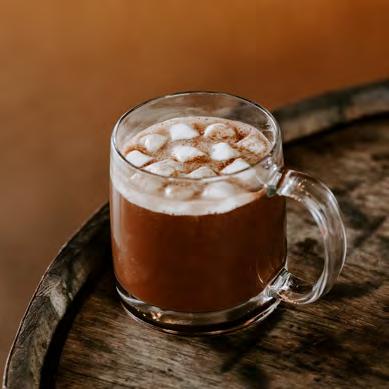
Courtesy of Katie Tobin, Bar Manager at New Riff Distilling, Newport
1 ounce New Riff Kentucky Straight Bourbon
1 ounce water
1½ ounces dark chocolate fudge dessert topping
½ ounce Luxardo cherry juice
1-2 dashes cherry bitters
1-2 dashes Aztec chocolate bitters
1½ ounces bourbon cream (recipe follows)
Chocolate-covered cherries (optional garnish)
Marshmallows (optional garnish)
1. Add all ingredients except the bourbon cream to a mug. Microwave for 1 minute and stir. Microwave another 30 seconds to 1 minute.
2. Add bourbon cream and garnish with chocolate-covered cherries and/or marshmallows.
1½ cups evaporated milk (one 12-ounce can)
1 cup bourbon
2/3 cup granulated sugar
Chef
Note: “We think the best part
when you reheat it for another supper. At the freight house, we work on a
plancha. But your grandma’s well-seasoned cast-iron skillet will do even better. We suggest that you make this a day ahead, let it cool overnight, and portion it cold. This allows for an easy pickup at parties and less cleanup. Plus, everyone gets the crispy ends! We work closely with one family farm for all of our bison meat. Benton Bottoms Bison is located in Benton and run by the Copeland family. They treat their animals like royalty, and it comes through in the flavor.”
1 teaspoon vanilla extract
½ teaspoon instant coffee
Combine all ingredients in a quart-size mason jar. Secure lid tightly and shake until well combined. Store in the fridge.

A Mayfield resident realized a dream by starting a DIY blog that has evolved into a multimillion-dollar business
Brooke Riley knew she had to do something. She worked in the high-bill complaint department at the local utility company in Mayfield. “You get cussed out and yelled out. I heard it all,” she said. “At the end of the day, no matter how joyful you are, it just takes a toll on you mentally, and it’s just exhausting.”
It took a physical toll as well, landing her in the hospital with stroke-like symptoms. While there, doctors discovered heart issues that otherwise would have gone undetected and untreated. “Something had to give,” she said. “I just felt like this is not really where God wants me. It felt like something just stirring in my heart.”
That stirring turned into an idea. In 2015, that idea turned into a leap of faith—the launch of Re-Fabbed (Re-Fabbed.com), a DIY decorating-on-a-dime blog with a now-massive online presence and social media stardom, as well as Re-Fabbed Boutique (Re-FabbedBoutique.com), an online-only webstore that pulls in millions of dollars annually.
 BY JACKIE HOLLENKAMP BENTLEY
BY JACKIE HOLLENKAMP BENTLEY
Brooke’s work and success have been featured in national publications, including 2021’s Forbes Next 1000, which recognizes up-and-coming entrepreneurs.
• •
•
Initially, Brook’s idea was to write a simple DIY lifestyle blog about home decorating and how to do it on a budget. She wanted her husband, Brandon, on board. At the time, they were living in a single-wide trailer with their two young children while their new home was being built. “I told him, ‘I’m going to start sharing my stuff with everybody—all these makeovers I do, all these house flips. I’m going to write about it, and I’m going to tell stories that really engage people. And I’m going to get all these readers,’ ” Brooke said. “I had these huge dreams, not even knowing how to do this or run a website or anything about technology. At all. He was like, ‘OK.’ ”
“At the time, it was the best decision for our family,” Brandon said. “We had two young children, so, not only could she follow her passion, but she could be even more present in the lives of our children.”
After “googling everything,” Brooke decided to launch a Facebook
page and hold live, online events. “All of a sudden, they could see me saying these things, and they could hear my ‘Brooke-isms,’ and my country twang,” she said. “They connected with my blog on a totally different level and connected with me. We started becoming family, and my [Facebook] page began growing by leaps and bounds, which—as that was doing that—so was my blog.”
Eventually, Brooke took another big leap and quit her full-time job. “It didn’t make sense to the outside world why I would leave something like that for nothing except this dream, and most people don’t even know what a blog is,” she said.
Nevertheless, her popularity grew exponentially. Re-Fabbed now has more than 850,000 Facebook followers.
Those followers began asking about her clothes and her earrings and how they could buy similar items. “So, I thought, ‘How can I take this need and actually help them and provide something for them?’ ” she said.
Re-Fabbed Boutique was born in 2018. Shortly after, Brandon, while recuperating from bicep tendon surgery, saw the potential of the new venture. “I just fell into it and said,


‘Why don’t I take this off your plate while I am off for surgery?’ ” he said. “During that time, our little boutique that began in our spare bedroom blew up. We sold more in a month than I could almost make in a year.”
Now it was Brandon’s turn to take a big leap. He quit his full-time job just three months after his surgery. “The boutique, under his wing, has soared,” Brooke said. “It has absolutely amazed us. We will hit over $5 million in sales this year in the boutique alone.”
• • •

The Rileys now have a team of more than a dozen employees. No longer storing the boutique inventory in their bedrooms, they have a warehouse in Mayfield, with a second, larger warehouse set to open next year. They work with several contractors and buyers to keep their online-only shop up to date with their favorite trends.
“I still pick out some things, and I am still very much observant and watching what we’re getting and making sure it stays in line with what our people want and what we want and what I like,” Brooke said. “[The boutique] started out with me and what I like, because everything I
was wearing were obviously items that I liked, and it was what [our customers] liked.”
In addition to operating the Re-Fabbed blog and Re-Fabbed Boutique, Brooke hosts fee-based online coaching groups. “One day, I woke up and said, ‘I’m starting my coaching group today.’ I’m going to put it out there. There was no planning, but I had it in my head,” she said. “[It] came about from listening to my audience, once again knowing I had something


they wanted to learn and being able to tap into that and help my family but help them as well. That was something I didn’t plan to do, either. It just happened.”
Brooke called the coaching program one of the most rewarding aspects of her life.
“There are careers out there for everybody with a passion,” she said. She wants her followers to realize that they can create something valuable for themselves when they do what they truly love and for which they have a talent.
It took getting screamed at daily at work, a health scare, and a lot of courage to get where they are today. The Rileys know taking that first step can be scary, but there’s “never going to be a right time” to work on a passion.
“It didn’t feel like it made sense to start a boutique out of a singlewide with four people living there when you had no space,” Brooke acknowledged, “but it worked out. When you take that leap of faith, just run with it and do what you’re being called to do.”
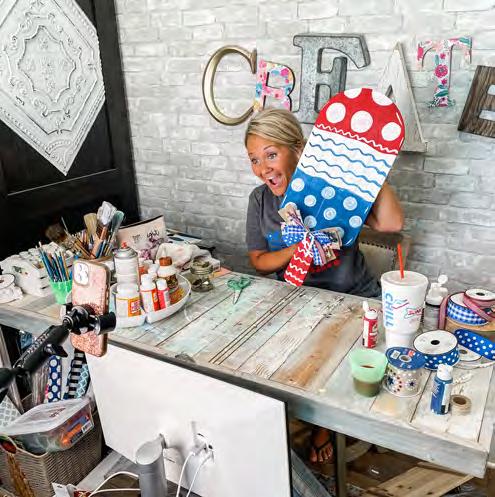

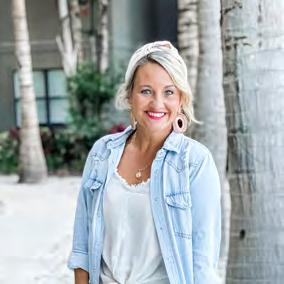


“Riley’s Christmas shadow box is perfect for Christmastime, but I like to keep some winter decorations up for a few weeks after the holidays, so I got cocky and departed from her design to make a little winter wonderland (with an extra large ornament if you’re going by perspective).”
scan for diy instructions
“Riley’s blog entry on turning a cheap gumball piece into a cute Christmas decoration caught my eye. But I did skip a few steps and bought dollarstore miniature ornaments, instead of painting them. I braved an attempt to convert an old candle jar into something festive.


“I did the same with the gumball transformation, exchanging traditional holiday colors with blues and silvers.”
Every now and then, I get an assignment that makes me squeal. “We’d like to run a profile on Mayfield-based blogger/entrepreneur/DIYer Brooke Riley,” my editor wrote. “Also, we’d love to include Christmas decorating on a budget.”
Interview a person who made a successful career creating crafting projects for pennies on the dollar? Write a story with her tips and tricks on using your imagination and inexpensive items? Make more Christmas decorations? Yes, please!
“Eric, we’re going to the craft store!” I announced to my husband shortly after getting the assignment.
After poring over Riley’s website, Re-Fabbed.com, I found a few items I figured I would attempt to recreate. They looked easy enough. “The easier the better,” Riley said during our Zoom conversation to discuss her blog’s meteoric success. “I do easy things. It’s not that I can’t do harder things, but I just love to share those easy projects that you can get done in a short amount of time and have something beautiful to show for it.”
It took a while to go through all her projects. A simple “Christmas” search on her site resulted in 46 pages of all things holidays. “I’m well known to be a Christmas fanatic,” she confessed. “You walk into my house, and it’s like Santa’s workshop threw up. A winter wonderland—that’s my jam.”
Finding inexpensive holiday items at the end of October wasn’t difficult, considering Christmas began taking over store shelves three months before.
With the necessary paints, miniature ornaments, wreaths, etc. in hand and maybe a few more items that I MAY need later, and my husband—bless him—trying not to be the Grinch that he tends to be this time of year, I cleared my kitchen table and got to crafting.
I made a few changes and substitutions to fit better with our usual holiday décor. Riley emphasized that’s exactly what you should do. She has her favorite go-to’s as well. “I like to use candies, like peppermints and gumdrops, and use those in apothecary jars for a punch of color or whatever your style is,” she said. “Let’s say you just have a basic bedspread in your bedroom but you want to have that festive touch. You can go find a really cute Christmas table cover or even just a red one and throw it along the end of your bed … usually for $10 or $15.”
Another favorite decorating trick Riley employs is to strategically place bits of decorated greenery—called picks—at various points in the house. “I love to use picks with the greenery or little pinecones that would stick in something or make an arrangement. I stick those all the time in and around everything,” she said. “You can have a little Santa sitting there and you stick a pick beside it, and it changes the whole look. And it’s just a dollar or 50 cents. I have hundreds of those that I’m sticking in different things along the way just to spruce up the decor.”
I did grab a few picks—some items that “I may need later” to make our house look like it was decorated by a professional. I’m not sure where I’ll stick them, but hey, if it makes my house look trendy and festive for only a dollar each, I’ll find some spots.
Altogether, my new holiday pieces cost roughly $20 (not including the I-may-need-these-later items). So, yes, you can flex your inner interior designer and not break the bank.
“There are so many ways you can decorate for Christmas on a tight budget and still make it look like you weren’t on a tight budget,” Riley said.
For more decorating-on-a-dime ideas, check out Re-Fabbed’s blog at Re-Fabbed.com and her Facebook page at facebook.com/refabbedbybrooke

A stay in a Kentucky cabin takes the visitor back to the days of the pioneers or Depression-era laborers—and away from the noise of modern life
TEXT + PHOTOS BY SEAN PATRICK HILLIt is Christmas Eve. In a small creek valley, a 4-mile walk from the Big South Fork of the Cumberland River, several log cabins sit in a field. In one, a man carefully stacks wood into an iron stove. The room is warm, though the air outside is bitter cold. It is evening, already dark—the waning moon will not rise for many hours—but the sky is awash with stars, the Milky Way clearly visible, with Venus, Saturn and Jupiter strung like beads along a forested ridge. Beyond the sound of the creek, there is only silence.
The man crosses the field to a lodge fashioned of logs. Inside, another iron stove—this one far larger—has burned for hours. A dog lies in the shadow behind it, dozing. There are other people here, too—an older couple from Tennessee. The man pours a cup of tea. He eats dinner by the light of an oil lamp,
listening to the conversations of the couple, talking about trails through this rugged country.
After dinner, the man wanders to a small cemetery at the edge of the meadow beside a brook. Longhunters, he was told earlier, are buried there beneath simple unmarked slabs of sandstone, the primary rock in these mountains. The few marked graves are of pioneers, carved with birth dates from the late 1700s.
Late into the night, the man sits in a wicker rocking chair beside the fire in his cabin reading a manuscript. Drowsy, he retires to a bed near the stove. Throughout the night, he wakes and feeds the fire. Come morning, on Christmas Day, he dresses in wool clothes, packs his belongings, and crosses Station Camp Creek on a swinging footbridge, climbing out of the valley past slim waterfalls, through groves of rhododendron and fern.
•
Such a story could have taken place 200 years ago—the original portion of Charit Creek Lodge was built in 1817 as part of a hunting camp—but it happened last winter, and I was that man. For the duration of my stay in the cabin near where Charit Creek empties into Station Camp Creek, I had few modern conveniences. I read my manuscript by the light of a propane lantern. Crossing the field for meals, I wore a battery-powered headlamp. Though I had my cell phone, there was no reception and no internet—in fact, no electricity for miles in any direction. My car, parked on the ridge, was a mile away, left at the end of a gravel road. Everything I brought to the cabin—a large-format camera and its gear, several days of clothes, a towel, a few toiletries—I carried in a 70-liter backpack.
I went to Charit Creek Lodge to be away from the city, away from social media, out of earshot of the noise of everyday life. I was in the Big South Fork National River and Recreation Area in Tennessee not far from the Kentucky border. A mile from the lodge are two enormous sandstone arches—the Twin Arches, North and South. A waterfall threads the hills farther down a trail.
The Big South Fork area, administered by the National Park Service, encompasses 125,000 acres of the Cumberland Plateau, stretching from McCreary County, Kentucky, into Tennessee. The day after the winter solstice, I drove out the Divide Road, parked my car on the ridge, and hiked down, the wind biting cold, ice edging much of the rock along the cliffs. The way to truly experience this place, I reasoned, was to stay here—not just overnight but for three nights. I wanted to see the place without having to worry about a five-hour drive home in the dark. To give up electricity, my phone and what had become—for better or worse—my connectedness in the internet age were small sacrifices.
In return for my walk, for keeping my fire going through the night, and for the exertion of climbing in and out of the valley each day to explore, I treated myself to breakfast and dinner at the lodge and a sack lunch for day hikes. I drank coffee before dawn, then sat down to sausage and eggs, biscuits and gravy, and warm blueberry muffins. In the evening, I
ate pork tenderloin, chicken and dumplings, grilled potatoes, Brussels sprouts and apple cobbler. In the flicker of the oil lamps, I talked to others staying there about their adventures on the Appalachian Trail and the enduring work of the Civilian Conservation Corps in Appalachia.

The first morning I went to the lodge, passing the kitchen (the stove and refrigerator, I later learned, ran on propane), I heard a banjo and singing in the distance. Coming closer, I realized that the song was “White Christmas.” It was not white while I was in the valley; nevertheless, it was a holiday to celebrate. • • •
The cabin in America is mythic. We think of Henry David Thoreau at Walden Pond, sheltering in the cabin he had built with an axe borrowed from Ralph Waldo Emerson. We think of the Western frontiersmen in an isolated mountain valley, a string of smoke wafting from a stone chimney. We imagine ricks of firewood, a fire kept going at all costs. The cabin is as romantic as it is rugged.
A cabin, so defined, is a small dwelling usually of simple construction, usually built of wood. We may think of cabins as being built of logs and many are. As it was for Thoreau, a cabin often is set outside of society, in the woods or the fields, beyond the bounds of the town. It is resolutely individual, even lonely.
For many years, I have been enamored of the idea of the cabin.

When I lived out West, it was not uncommon to find cabins in the mountains, on national forest land, that were open to the public. One could camp in them. Sometimes, as with an old gold miner’s cabin I once visited in the Blue Mountains, they were stocked with canned food, spartan mattresses and kindling.
In Kentucky, perhaps the bestknown cabins for temporary lodging are in the Red River Gorge in Wolfe County. I have visited cabins in the area: once with a friend from Oregon, an A-frame set on a hillside above Martin’s Fork, and another time in a farmhouse near Raven Rock. The farmhouse had plumbing and electricity. The A-frame had a pit toilet outdoors. All of them are marketed as “cabins,” and in the Red River Gorge or anywhere else, they vary in how rustic they are.
A decade ago, I stayed at the Gorge campgrounds and slept in my tent. Now, I go to photograph, and with the expensive gear I have—not to mention the frequent turns in the weather—tent camping is not feasible. And though I am hesitant to admit it, I no longer want to sleep on the ground. I wanted to photograph throughout the Cumberland Plateau— the Red River Gorge, Cumberland Falls, Pine Mountain and the Big South Fork. I began to research cabins online and made reservations throughout the mountains.
• • •
Late last autumn, I climbed a trail
Cabins in Kentucky—and nearby Tennessee—can be reserved easily online. Here are a few writer/photographer Sean Patrick Hill has written about and some he has yet to visit.

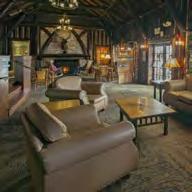
Located in the Big South Fork National River and Recreation Area, not far from the Kentucky border, this rustic backcountry lodge— possibly the oldest operating lodge in the National Park Service system—must be accessed via hiking. Vehicles are not allowed. There are three cabins and two lodge rooms, and meals are provided throughout your stay.
865.696.5611

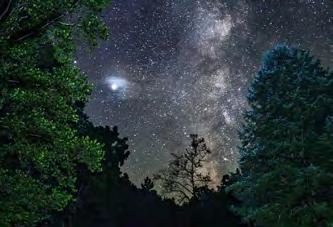


With access to the Cumberland River, numerous waterfalls (including “The Niagara of the South”), the Sheltowee Trace and a state nature preserve, the park is ideal for a several-day stay. The original CCC cabins have full kitchens, and smaller cottages are available.
606.528.4121
You can see Mammoth’s miles of limestone caves, paddle the Green River, or hike the backcountry and make a day or two of your visit. Spend the night at one of the Historic Cottages or the more rustic Woodland Cottages.
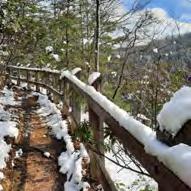
844.760.2283
Laurel Cove, Chained Rock, Honeymoon Falls, Powderhorn Arch— there are plenty of sights, trails and lodging at Pine Mountain. Pine Mountain has three original CCC cabins and several newer—but just as romantic— cottages. Ask the park employees which are which, and they’ll be glad to help.
606.337.3066
past Cumberland Falls. It was early morning, the weather was cool, and I was watching my steps over the wet sandstone. I headed downriver toward Eagle Falls, which I’d never seen. Even at that time of year on the Cumberland Plateau, the Kentucky forest is deep green in places; rhododendrons, mountain laurel and maidenhair ferns hold the last breath of summer. The hemlocks and cedars keep their leaves and needles. The sky that morning was cloudless.
In my backpack, I carried my largeformat camera, some 20 sheets of film, pouches of lenses, a light meter and cable releases. I arrived at Cumberland Falls State Resort Park at the optimal hour for shooting photos. Later that day, I hiked into the Daniel Boone National Forest, south of the park, to Dog Slaughter Falls.
I rented a cottage on the hill above the falls. From the small porch, where in the mornings I made coffee on the Coleman stove I’d brought, I could see the main lodge. When I returned in the afternoons, I could watch the sunset. In the gathering dark, I watched Juncos in the cedars.

This is one of the blessings of Kentucky’s state resort parks: that one can stay overnight within the confines of the park. The cottages are modern—they each have a microwave oven and a small refrigerator. The bathroom allows hot showers, and there is even WiFi. The cottage has the amenities of an ordinary hotel room—the difference being the location, 15 miles from the nearest
freeway. Without traffic noise, I hear only wind in trees.
The Red River Gorge is easily a day trip from Louisville, especially in the summer months. But in the winter, a place like Cumberland Falls—a bit farther from the city—is not easily visited for a day. Rather than leave long before dawn and drive three hours on the freeway to see the falls, only to turn around at the end of the day and drive home in the dark, I elected to rent a cottage and settle in. A two-night reservation at a cottage affords one full day of exploring. On the day I arrive, I get to explore a bit of the park, and on the day I leave, I can see even more.
From the Sheltowee Trace, which follows the Cumberland River downstream from the falls, you can see a massive rock shelter beneath the cliffs across the river. Native Americans lived in that shelter. To have slept that close to the falls must have been an incredible experience.
Today, we can only visit. My task is to come as close as I can to belonging in a place. Staying in the cottage at Cumberland Falls was good, but I wanted something more rustic, more primitive. I found what I wanted on Pine Mountain.
mountain above the Herndon J. Evans Lodge, and it served as a base camp to explore the Pine Mountain Trail, which was north, toward Cumberland and Whitesburg. After hiking out of Letcher Gap and ambling over the mountain, it was a comfort to come back to the cottage, build a fire in the stone fireplace, and draw a hot bath.
The second time I stayed at Pine Mountain, I took a room in the lodge that was not unlike a hotel room. It was comfortable, but I wanted to experience one of the cabins built by the Civilian Conservation Corps, likely in 1938, when most of the park was developed under President Franklin D. Roosevelt’s Depression-era program.
The original CCC cabins—there are three of them at Pine Mountain—are set up a steep road not far from the original lodge, which the CCC also built. They were constructed at a time when outdoor recreation was truly becoming an industry. Ansel Adams had, by then, already made the national parks famous with his photographs.
L.L. Bean had been in business producing outdoor gear for a quarter century. Pine Mountain was Kentucky’s first state park, and what the young men of the CCC built is emblematic of the value then placed on the outdoor experience.
The first time I stayed in a cottage at Pine Mountain State Resort Park, I was on assignment for Kentucky Monthly. It was a January weekend; the weather was pleasant. I rented a cottage set on the side of the

The cabins were built of logs felled on the mountain, and the foundations were cobbled of locally quarried stone. Each cabin is, for the most part, a single room (a bathroom has been added), and in the center of the room is a bulky stone fireplace.

The entire cabin was built with care and precision.

From the cabin, the view reached to the Log Mountains, and from my porch—I’d go out there often, gathering the firewood the park provides for visitors—I watched the sunset over the ridge of Pine Mountain. I built a fire. What made the experience more romantic than it already seemed was the fact that I had arrived just ahead of a snowstorm.
I managed to get into the cabin before noon. By mid-afternoon, snow began to fall steadily. Within hours, the road was covered. I had been told that the road would not be plowed until, at best, the next day. But I had food, warm clothes, a book, and my computer. Though there was electricity, there was no internet and no WiFi. This is what I came for: snow and silence.
The next morning, I woke to at least four inches of snow. The clouds were blown off by midday, and the sky was a piercing blue. It was 12 degrees when I woke, and the temperature did not change significantly throughout the day. I spent the day in the cabin, tending the fire, doing yoga, reading and drinking coffee. When the temperature rose a bit, I went outdoors with my large-format camera and photographed the snow-covered trees. I later heard the snowplow scraping up the road and found myself wishing the road would never be cleared. When I checked out, I told the woman at the front desk that I’d live in that cabin if I could. • • •

There are cabins throughout Kentucky. Cumberland Falls State Resort Park boasts six CCC cabins, and Mammoth Cave National Park has several historical cottages built by the CCC—some without heat and air conditioning and available only seasonally. Numerous private companies offer cabins throughout the state.
It is, to me, thrilling to know that I can experience the mountains and forests of Kentucky the way the CCC builders likely intended me to: from rooms built of the mountains themselves, their stone and their trees.
On Friday, Dec. 10, 2021, Cliff Key and his husband, Chris Cates, were looking forward to kicking off the weekend by celebrating their nephew River’s fifth birthday in their new home, a cozy two-bedroom ranch on Alexander Street in the small western Kentucky town of Dawson Springs.
Both men work with adults with intellectual disabilities. Cliff is executive director at LucasaCare BG, a foster care service for adults in Bowling Green, and Chris is a training coordinator at Outwood, a residential care community living facility in Dawson Springs.
The first-time homeowners had just moved in a couple of months previously and still had some of their possessions in boxes, but they had the Christmas tree up, to the delight of the birthday boy and his 9-year-old brother, Alex.
It was starting to look a lot like Christmas, but it wasn’t starting to feel like Christmas. The weather was unseasonably warm.
The family enjoyed a small but festive birthday party. River blew out the candles on his cake decorated to look like the Minecraft computer game. The kids spent the evening playing video games and watching cartoons. They
finally went to bed happy and exhausted.
As Cliff and Chris tidied up, they kept an ear to the TV. Weather advisories aired every few minutes warning of a possible tornado in Hopkins County, but the couple had lived through many such advisories during their 17 years in Dawson Springs and had never been hit. Besides, spring was tornado season.
Everything changed in an instant. The tornado was no longer possible but imminent. The TV meteorologist was urging Dawson Springs residents to take immediate cover.

Around 10 p.m., the couple rushed to awaken the boys. They bundled them into the hallway in the nick of time. “They were terrified, as were we,” Cliff said. “All we could do was shelter them with our own bodies.”
When it was over, Chris, who had been protecting Alex, was pinned beneath the wreckage of the house. Cliff and River were under an interior door that had blown off its hinges. The door probably protected them from missiles of flying debris, the cause of most deaths and injuries during a tornado, according to the National Weather Service.
The kids were in a state of panic. A relentless rain was pouring in where the roof had been. The power was out, and they were trapped in the cold, dark shell of a house
A year after the devastating tornadoes that struck western Kentucky, Dawson Springs residents remember that fateful night and look to the future
that had been warm and inviting minutes before.
Fortunately, Kenny Mitchell, a neighbor and city councilman, heard their calls and helped dig them out.
Miraculously, they all emerged from the rubble with minor injuries and slept in the Mitchells’ basement that night. Through lightning flashes, they glimpsed the remains of their new home that now looked like a bomb site.
They didn’t know it at the time, but the family had survived the deadliest 24-hour period for tornadoes on record for December in the United States. The long-track EF4 tornado (EF5 is the strongest tornado classification) had stayed on the ground for 165 miles, with 180-mileper-hour winds sweeping through six states, including western Kentucky.
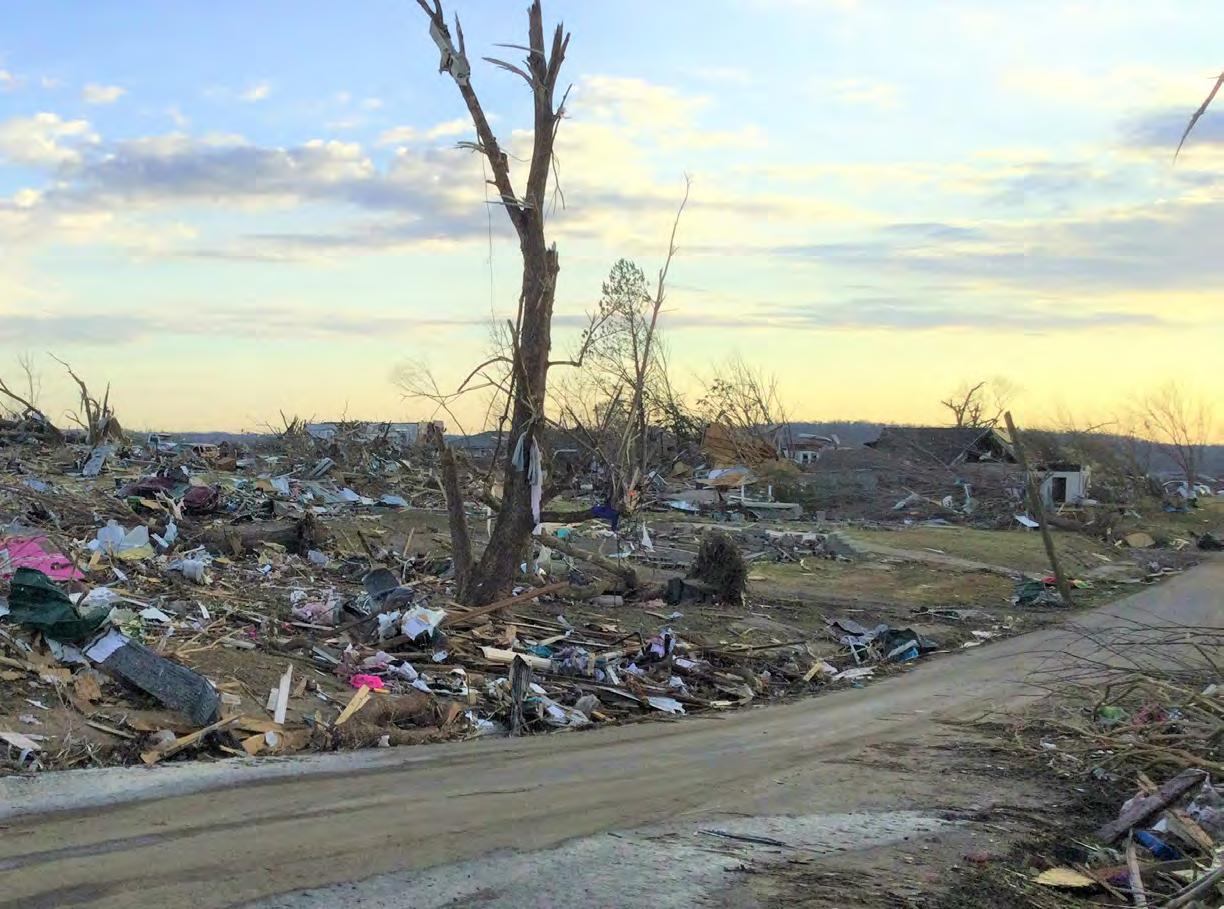
About 75 percent of Dawson Springs was wiped out. Thirteen people were dead (two more died later in the hospital), and hundreds of the town’s 2,500 residents no longer had homes. The devastation was such that residents couldn’t tell what part of town they were in because well-known landmarks were obliterated.
“I had the mindset that it would go around us,” Chris said. “They say it’s going to hit all the time. It always misses Dawson.”
Dwelling on the “what-ifs” of the situation filled him with guilt for not evacuating with the children while they had the chance.
Their neighbor, 76-year-old Donna Parker, also thought the tornado would miss Dawson Springs. The retired high school secretary lost her home of 44 years and was among those who sheltered in the Mitchells’ basement before the tornado hit. She and her late husband, Phillip, had raised three children in their simple frame house built circa 1943.
She has fond memories of working in the garden and hanging out with friends on the deck.
A year later, it’s still difficult for Donna to talk about the moment she came out of the basement, where she had been safe but shaken to the core by the sound of the windows being blown out. Her son had arrived to take her to his home across town, but she said just making their way to the car through the rubble was an ordeal.
“I could hear people hollering for help,” Donna said. “That was the worst part—not knowing where they were or how badly they were hurt.”
She was struck by the randomness of the destruction. An outbuilding was blown away along with the lawnmower and patio furniture that were inside, but
some of the most fragile items in her home were eerily undisturbed. Vintage glass family heirlooms were intact, and her Christmas tree, adorned with delicate ornaments, stood like an indestructible monolith.
This nightmare before Christmas was a blow to the entire community, but Donna knew she was lucky to be around to spend the holiday with her family. Three of her friends were not so fortunate.
She was determined to carry on with at least one longstanding family holiday tradition. “Every year at Christmas Eve, we make gingerbread houses,” Donna said. “I had already bought all the gingerbread house kits. I said, ‘If we don’t do anything else, we are going to make our gingerbread houses.’ ”
Cliff and Chris would have spent Christmas at Cliff’s mother’s house, but she had lost her home, too.
They spent the holiday with an aunt and lived with her for several months as they rebuilt their home.
When Chris Smiley was elected mayor of Dawson Springs in 2019, he thought his main administrative responsibility would be presiding over city council meetings and overseeing public-works departments, such as fire and police, that keep the city going.
He couldn’t foresee that he would be called on to lead a community devastated by a natural disaster of Biblical proportions in the midst of a once-in-a-century global pandemic.
Nor did he ever dream he would be on the radar of the president of the United States, much less meet him. But on Dec. 15, Smiley was at the Princeton-Caldwell County Airport to greet President Joe Biden. Smiley rode in the presidential motorcade to Dawson Springs and escorted the president on a tour, so that he could see for himself the deep wound of destruction that now defined the town.
Biden said the federal government was committed to the rebuilding effort and promised it would cover 100 percent of cleanup costs for the first 30 days. Smiley recalled that Biden kept the Secret Service on its toes by walking up to random residents, especially children, to reassure them.
Smiley said the security presence—the Secret Service, snipers and armored vehicles—was completely
overwhelming at a time when his mind was still reeling. “That was something this small-town boy had never seen before,” he said with a laugh.
The presidential visit meant a great deal to residents and boosted morale.
“That was a time when you didn’t worry about who’s a Democrat and who’s a Republican,” Smiley said. “We just had to get people back in their homes and help survivors.”
Some displaced residents were living in nearby Pennyrile Forest State Resort Park in travel trailers provided by the Commonwealth Sheltering Program.
Gov. Andy Beshear and First Lady Britainy Beshear organized a toy drive to make sure every Kentucky child impacted by the tornado had a Christmas gift, even if they didn’t have a home with a tree to put it under.
Walmart turned the Dawson Springs High School gym into a store with free necessities and toys.
Assistance poured in from many sources around the country. “You don’t realize how many good people there are in the world until a tragedy like this happens,” Smiley said.
One year later, the rebuilding process is in full swing. Smiley said that FEMA has contributed $150,000 to the community, and more aid is expected. The city has built 30 houses, and Habitat for Humanity has built 20.

Donna is looking forward to hosting a family Christmas celebration in her new house on the site where her old one stood. A cheerful living room with pale green walls and hardwood floors is just big enough to entertain family and friends. A kitchen with white cabinets and shiny countertops will be a hub for holiday meal preparations. Soon, her children and grandchildren will sit at the kitchen table and make gingerbread houses.
In a house where virtually everything is new, an antique cabinet full of Donna’s precious glassware makes her new place feel like home.

As for Cliff and Chris, they are rebuilding in the same neighborhood and are pleased with the progress. They are expecting a “cheery and fun” holiday season.
“If we can get back into our house, that’s all the Christmas I need,” Chris said. Q









A Santa Claus performer connected with tornado victims—and with the late, beloved singer-songwriter who put Muhlenberg County on the map
BY ART HOFFMANChristmas promised to be 75 degrees and sunny. But that was not the most remarkable aspect of the day when Mrs. Claus and I headed out for a special visit. The destination was Bremen, a small Muhlenberg County town ravaged by an EF4 tornado on Dec. 10, 2021.
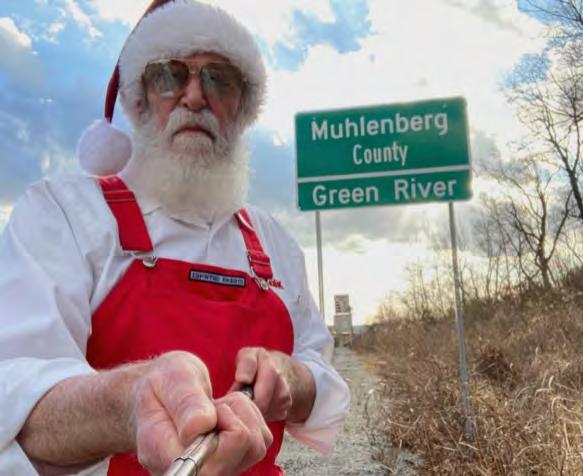
After almost a half-century portraying St. Nick, I had developed a routine. Typically, it involved gleaming malls and social service agencies, schools and churches, and even intimate home visits. My appearances incorporated the customary suit and the Santa hat with the fuzzy ball on its tip. On the day we visited western Kentucky, I sported my Santa hat even if it did not exactly match the color of my bib overalls.
Since the beginning of the COVID-19 pandemic, I have been wearing another cap. It’s my “public health hat,” which became important once the virus changed things almost overnight. I was proud of a professional career as a public health official dating back to the 1970s that helped guide me and inform others on how we can navigate through these difficult times.
As soon as we reached the county line and saw the highway sign, I heard John Prine’s iconic song in my
head. In preparation for this trip, I had even mischievously altered a famous line from the tune. It became, “Santa, Won’t You Take Your Bag to Muhlenberg County.” “Paradise” was nearby, though the landscape ahead would prove to be hellish.
Another alter ego then emerged. I am a Prine fan. I was traveling the same roads and byways that he had ever since he was a small boy, but this would be my first time. I wondered if I could effectively “channel” Prine that day. Many fans knew that Prine loved Christmas and Santa Claus. His widow, Fiona, recalled that John cried in 2016 when they attended the Christmas Spectacular at New York City’s Radio City Music Hall, reporting that “the colors, the lights, the idea of family, togetherness, bestowing gifts, it means a lot to him.”
I thought about what Prine would have felt about the aspects of Christmas that Fiona described in the midst of horrendous circumstances following the tornado. There was no way to know. He died of COVID on April 7, 2020, right at the outset of the pandemic. Had he been alive and healthy at Christmas, he might well have made his way to Muhlenberg County. I was a bundle of emotions at that point. I was sharing some of this with Mrs. Claus as the town came into view.
Our expectations were fairly simple as we pulled up to the convenience store/gas station known as Nickolas’ Corner, feeling welcomed by the name. This was one of the main gathering places in town. I thought we’d meet some families, entertain the kids, pass out some stickers and trinkets, and distribute toys donated by folks in Louisville. Two things immediately became apparent. The toys we had brought were mostly unnecessary. There had been such an outpouring of support from throughout the state—indeed, across the country— that the youngsters seemed to have had their fill. So, the “gifts” I could provide as Santa would be the intangible ones— smiles, making small talk, dancing in the parking lot, and demonstrating a classic acrobat toy at which the kids marveled. Even in 2021, there was something to be said for non-tech stuff. Often, simple is better.
My other revelation was that, in a town with so much property damage, injuries and loss of life, I worried that voicing some “ho ho hos” or relaying “Merry” Christmas wishes would somehow be inappropriate. I quickly learned that fear was unfounded. The townsfolk, and especially the kids, were craving exactly that. They were ready for this halting step toward normalcy despite the obliterated landscape literally just a mile or so from where we assembled. Their resiliency was astounding. My mission—to spread some “comfort and joy”—was proving to be a bit easier than I had envisioned. Presents were exchanged by just our presence.
After a few hours at that location, Mrs. Claus and I moved into the “tornado zone.” It was then that the scope of the destruction became apparent. A small part of me remembered that Prine had engaged in “pewdustin’ ” (his phrase) as a teenager while working for a church. (I also did custodial work for a church as a young man.) Surveying the leveled buildings, it was evident that area houses of worship were going to need much more than towels and brooms. In some areas of western Kentucky, they were obliterated. Prine had seen this same landscape destroyed by strip mining some 50 years earlier, with the culprit being Mr. Peabody’s coal operation. I imagined his pain in seeing similar destruction now but owing to a very different reason. My philosophizing would soon come to an abrupt end. I was about to meet Inez. Just south of the worst damage, we spotted a roofing crew installing a roof on the home of 92-year-old Inez Burden. Such was their dedication to the cause that the roofers were working on Christmas Day. Interacting with the owner of the company and his guys was poignant enough, but then Inez and her daughter emerged from the backdoor. I learned that, during that terrifying night, Inez hunkered down in her basement while her daughter in Lexington was frantically trying to stay in contact despite cell phone coverage cutting in and out. Their tale was harrowing, but with Santa now standing on their back porch, the mood lightened. Santa had come to visit, while technically not from the North Pole, clearly from out of the blue. I persuaded Inez into a brief waltz with, “How often do you get to dance with Santa Claus on Christmas Day?” This was followed by hugs and a spontaneous plan


owns Applied Art and Design in Fort Thomas and is the author and illustrator of The League of Outsider Baseball: An Illustrated History of Baseball’s Forgotten Heroes
Left, on Santa Art’s visit to the tornadostricken area, presents were exchanged just by his presence.


to return next Christmas under happier circumstances. Maybe this is a Christmas tradition in the making?
Reading through a newspaper published three days earlier out of nearby Central City, I noticed it had page after page of letters from children listing what they wanted for Christmas. Scores of sweet, innocent letters from 8- to 11-year-olds unaware, when they wrote them, that their lives were about to be turned upside down. The poignancy of realizing the letters had been written before the tornado hit was not lost on me. I related with area residents who must have read them with a lump in their throats. My lump was large. Every one of the notes was addressed to Santa, to me.
Another section of the paper included a letter from the local mail carrier. Because Prine had worked as a mailman (and I had, too), this caught my attention. In an eloquent accounting of what the past two weeks had been like for the mailman, one sentence stood out: “I found out today that one of the pets that lost its life in the tornado was a dog that the little girl at the home had named after me.” My mission went from heartwarming to heart wrenching just that quickly. The roller coaster of emotions would continue throughout the day.
• •
•
With enough remaining daylight hours left as Mrs. Claus and I headed out of Bremen, I thought we should include a visit to Paradise itself. Santa’s sleigh knew the way. Thirty minutes later, we turned left from John Prine Avenue, not exactly sure what to expect. A deserted road beckoned us, made even emptier since it was Christmas
Day. Many of the signs and structures described scenes a half-century ago. This was a slice of Americana I had heard about forever, it seemed, and now, I was immersed in it. I knew I had been handed my second gift of the day. Uplifted by the experiences in Bremen, I was buoyed by the pleasure of seeing more of Prine’s boyhood memories right where they had evolved.
Soon, we were back on the Western Kentucky Parkway headed east. The sunset behind us on that late winter afternoon echoed Prine’s lyric: “I’ll be halfway to heaven with Paradise waiting; just 5 miles away from wherever I am.” Mrs. Claus and I felt Prine’s presence as we looked up. The celestial light show was powerful in every section of the sky. I’d like to think that Prine would have approved of Santa out visiting Muhlenberg County on Christmas Day to spread “comfort and joy.” Was that little patch of turquoise in the sunset Prine signaling his approval? I am sentimental enough to think that.
As I look back on the months since Christmas Day 2021—as well as the past 50 years when Prine first introduced America to Paradise, “the backwards old town that’s often remembered”—I feel that I unwittingly became part of a story that has come full circle.
Many elements made last year’s holiday my most unusual Christmas Day ever. A tornado prompted the visit. But I became entwined more than I could have imagined with the lives of some of these residents and the spirit of a legendary songwriter. I tried to honor Prine’s life while simultaneously embracing the people of his county. My whirlwind of emotions continues to this day. Q
The lifelong friendship of Rosemary Clooney and Blanche Chambers defied the segregationist conventions of their youth
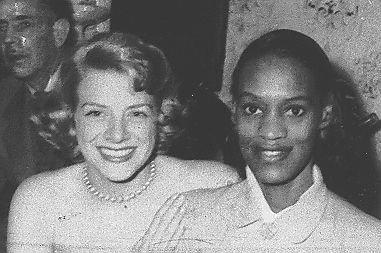 BY JACK BRAMMER
BY JACK BRAMMER
The mural on the Maysville floodwall a stone’s throw from the Simon Kenton Memorial Bridge honors moments from the life of hometown star Rosemary Clooney, known for her singing and acting. A large part of the 2007 artwork is a black-and-white drawing of Clooney perched on the backseat of a convertible wearing a mink coat. She is smiling broadly.
It was one of the best days of her life. At 24, she was back in the Ohio River town for the 1953 world premiere of her movie The Stars Are Singing at the popular Russell Theatre. Tens of thousands had joined her at the dedication of a street in her honor. A parade marked her arrival.
Beside Clooney throughout the festive day was her pal since childhood, her best friend Blanche Mae Chambers. She is the Black woman sitting in the front seat of the convertible between two white men.

Some city dignitaries had said, “No,” when Rosemary wanted Blanche, who was 28, to ride in the convertible with her. Those were the days of segregation. “Then no parade,” said Rosemary, who finally got her way.
The parade went off without a hitch in the city, though a local news report dismissed Chambers as “Rosemary’s maid.”
“It’s a story of great friendship. It started when they were young and lasted throughout their lives. They were inseparable,” said David Cartmell, mayor of Maysville from 1998-2018.
•
Rosemary was born on May 23, 1928, the daughter of Marie Frances (Guilfoyle) and Andrew Joseph Clooney, a house painter. She was one of five children. She and her sister, Betty, often sang in the successful mayoral campaigns of their grandfather, Andy Clooney, and at various events in the community.
Blanche was born on Feb. 3, 1924, the daughter of Lizzie Smith and Gilbert Chambers. They did janitorial and custodial work.
The Kentucky Gateway Museum Center in Maysville has a two-page letter written by Blanche with the title, “I Grew Up with Rosemary.” It details the beginnings of Rosemary and Blanche’s friendship. It does not mention race. “Our friendship began when my mother worked at the New Central Hotel in Maysville across the street from the Clooney home [which was over the shop of a jewelry store],” Blanche wrote. The Central Hotel was on the west side of lower Market Street, close to where O’Rourke’s Pub is now.
“I would come down to stay with my mother after school each day, and there Rosemary would be, waiting for me to come over to her house to play,” Blanche wrote.
Blanche recalled they would play inside a large dollhouse that belonged to Rosemary, and Rosemary’s grandmother, Ada Guilfoyle, would fix cookies, sandwiches and milk for them. “We really had the time of
Above, the Maysville floodwall that honors hometown sweetheart Rosemary Clooney; opposite page, left, Blanche Chambers was close to the entire Clooney family, including Rosemary’s nephew, George; opposite page, center, the Rosemary Clooney House in Augusta.
our lives, in our own little fairyland,” Blanche related.
Nick Clooney, Rosemary’s brother and father of actor George Clooney, said the friendship was enhanced by the grandmother, who was “very open” about being kind and respectful to all people. He said she once washed out his mouth with Lava soap for language he used and gave him a spanking to boot. “I have never said that again,” he said.
Ada Guilfoyle is pictured in the floodwall mural, sitting in the backseat, her face visible between Blanche and Rosemary. Nick and Nina Clooney named their daughter, Ada, after Nick and Rosemary’s grandmother.

As girls, Blanche and Rosemary would perform sidewalk shows in front of the Clooney house. “Rosie would sing, and I would tap dance,” Blanche wrote. “We always got paid for our performance, too. Someone would usually walk by and hand us a nickel or dime, and right to the candy store we would march. Our choice would most always be ice cream or candy.”
The Clooney backyard contained a large swing on which the two girls would play trolley car. “One day when we were playing,” Blanche wrote, “Rosemary was the conductor, and while the swing was in motion, she fell, cutting her lip, but the injury didn’t faze her. Rosie was back the next day and all set to play trolley car and conductor again.”
The two girls, wrote Nick Clooney in his 2002 book The Movies That Changed Us, “could play together, perform together, but they could not go to school together, or drink from the same public fountain, or go to the movies together. For Blanche, there was always the balcony.”
Blanche wrote that Rosemary left with her mother and Nick when she was about 10 to live in California. About
seven years later, Rosemary returned to Maysville to sing as part of a duet in a sisters’ act, and Blanche and Rosemary spent time together. They saw each other again about three years after that, when the Clooney sisters were in town singing with the Tony Pastor orchestra.
Her “big thrill,” Blanche wrote, came in January 1953, when Rosemary came back to Maysville for the premiere of her first movie. The two young women spent the day together. At the premiere, Blanche watched from the balcony, while Rosemary gave a speech on the stage.
When the lights went off and the movie started, Rosemary, clad in a mink coat, made her way to the balcony and sat next to her friend. “We watched that movie and giggled like schoolgirls,” Blanche recalled. • • •
Rosemary’s 1954 movie, White Christmas—with Bing Crosby, Danny Kaye and Vera-Ellen—is a holiday classic. Songs such as “Come on-a My House,” “Tenderly,” “This Ole House” and “Sway” took Rosemary to national prominence. “Tenderly” was Blanche’s favorite.
Blanche stayed in Maysville, and the two became pen pals. Unlike Rosemary, Blanche never married or had children. She was a companion to an elderly woman and was devoted to the local Church of the Nativity, even conducting prayer services.
For about the last 20 years of her life, Rosemary lived part-time in a house she bought in nearby Augusta on the shores of the Ohio River. Former Lt. Gov. Steve Henry and his wife, Miss America 2000 Heather French Henry, have turned it into a museum to honor Rosemary. Nick lives a couple of blocks south.
The house provided Rosemary and Blanche the opportunity to see each other in the latter years of their lives. “You would see them together. Blanche visited a lot,” said Dorinda Perkins, an Augusta resident who works at the Rosemary Clooney House. “They so enjoyed each other’s company, even back in those tough days when you didn’t see white and Black kids running around together.” Perkins said Blanche “never had a bad word to say about anyone. She was a tiny, elegant woman, would never let anything get her down. Their friendship was based on love.”
“Blanche was very private. She rarely expressed her feelings to others, other than to Rosemary,” said Mary Julian Dudley, whose 96-year-old mother, Mary “Rosebud” Dudley, was a close friend of Blanche’s.
After Rosemary was hospitalized for lung cancer in January 2002, Blanche told a Cincinnati Enquirer reporter that she was “praying extra hard for her childhood friend.” As she spoke, she clutched her prized possession: a 1953 photograph of herself with her friend in a convertible in a parade in the town they loved.

On Saturday, June 29, 2002, Rosemary Clooney died. She was 74. The next morning, at 8 and 11 a.m. masses at St. Patrick Church on Third Street, a block east of the Russell Theatre, the Rev. William Hinds announced her death. He had officiated at Rosemary’s 1997 wedding to longtime companion Dante DiPaolo at the church. (Rosemary previously had been married to actor José Ferrer from 1953-1961 and 1964-1967.) Rosemary had opened her wedding to DiPaolo to the entire community. In Augusta on the day following Rosemary’s death, fans placed flowers at the front door of her twostory brick home. She was buried near family in St. Patrick’s Cemetery south of Maysville near the Washington community.
After Rosemary’s death, Blanche continued her service to her church and community. She was awarded the Maysville-Mason County NAACP Keeper of the Flame Award in 2007. “She was well known in her own right in this town,” said Ron Bailey, a Maysville historian. “Many people called her ‘Blanchie Mae.’ ”
Blanche Chambers died on Sunday, Jan. 11, 2009, at the local hospital. She was 84. Burial was in the Maysville Cemetery.
Former Mayor Cartmell, who often gives walking tours of Maysville, said tourists routinely ask about Clooney. “They want to know where she lived as a girl with her grandparents, the theater where she sang. And they then see the floodwall mural and ask what was going on. They want to know about the event,” he said. “After that, they ask about the Black woman in the convertible, sitting in front of Rosemary.
“I tell them they were the best of friends.” Q
The Rosemary Clooney House in Augusta is placing its large collection of memorabilia from the star’s 1954 sentimental movie favorite White Christmas on display this holiday season at the Behringer-Crawford Museum in Covington.

“We are so excited,” said Jason French, curator for the museum. “We have worked several months with the proprietors of the house—former Lt. Gov. Steve Henry and former Miss America Heather French Henry—to get the exhibit, and we are hoping to bring in many people to see it.”
The exhibit will feature costumes and other memorabilia from the movie starring Rosemary Clooney, Bing Crosby, Danny Kaye and VeraEllen, who was from Norwood, Ohio, about 10 miles from Covington.
Heather French Henry said the exhibit has been on tour at various cities during the holidays. She said it tripled attendance at a locale in Greenville, South Carolina, and played well in Oshkosh, Wisconsin. “There is an intergenerational love for the movie,” she said, adding that a book is expected next year with a pictorial history of the Rosemary Clooney House and White Christmas.
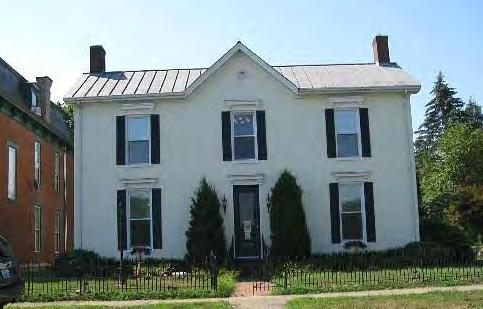
The Rosemary Clooney House Inc. is a nonprofit foundation and has 277 pieces in its collection of White Christmas memorabilia. Some of the collection, such as a large sleigh, will not be in Covington.
The White Christmas exhibit runs through Jan. 8.
Behringer-Crawford Museum
1600 Montague Road Covington, 859.491.4003 bcmuseum.org
The Jenny Wiley saga, with its tangle of facts and folklore, has intrigued audiences for more than 200 years
BY RON SOODALTERThe dramatic tale of Jenny Wiley’s capture by and escape from Native Americans has become a cornerstone of Kentucky history and lore. Yet, as is often the case when events lack reliable documentation, a story can assume a life of its own. As such, Wiley’s odyssey bears examination to see where fact ends and fancy begins.
This is one of the more generally accepted versions of her story.
Shortly before dark on a dismal, rainy Oct. 1, 1789, a combined raiding party made up of a dozen or so members of the Cherokee, Delaware, Wyandot and Shawnee tribes broke into the Walker’s Creek, Virginia, frontier cabin of Thomas and Jenny Wiley. It apparently was a reprisal raid—payback for an earlier skirmish in which some of their fellow tribesmen had been killed. Their specific target was a locally renowned Native fighter named Matthias “Tice” Harman, whose cabin stood only a mile or so from the Wiley home, and whom the Indians feared and despised. In the growing gloom, they missed the Harman homestead and struck the Wileys’ cabin by mistake.
Tom Wiley reportedly had left early in the day to market his ginseng at the distant New River trading post, leaving his pregnant 29-yearold wife, five children, and Jenny’s younger brother in the cabin. Her brother-in-law, whose cabin was 2 miles away, came by to warn of having heard American Indian calls in the surrounding woods, strongly advising Jenny to gather her brood and leave immediately for her sister’s cabin. She had been weaving and, believing she and her family were safe from attack until nightfall, determined to remain at her loom a little longer. It would prove a disastrous decision.
After finishing her weaving, Jenny took her 15-monthold son in her arms and—with her other children and brother in tow—prepared to leave the cabin. At that moment, the raiding party burst in and, without preamble, tomahawked her brother and her other four children to death before her stunned eyes. After scalping them and setting fire to the cabin, the warriors took to the woods, driving the dazed and devastated Jenny along with them. Her only remaining children were the one in her arms and the one in her body.
Fearing pursuit, the warriors set a rapid pace to the north with Jenny, seven months pregnant and clutching her small son, struggling to keep up. Their ultimate
objective was to cross the Ohio River and reach the safety of the Native towns on the far side. Over the course of the next several days, they forded several frigid, rain-swollen rivers and streams, including the Tug and the Big and Little Sandy, forcing their footsore, exhausted captive to wade and swim along with them. At one juncture, as Jenny watched in horror, they cut green sticks and fashioned them into hoops on which they stretched the scalps of her slain children. Shortly thereafter, Jenny’s small son took sick, and—fearing that his cries would give away their location—her captors dashed out his brains against a tree.
A rescue party led by Harman had set out in pursuit immediately upon finding the small bodies inside the charred cabin. For days, Harman and his men followed the Natives’ trail, at one point coming upon and burying Jenny’s recently slain child. Ultimately, they lost all sign of the raiders and were forced to turn back.
When the warriors were not on the move, they kept Jenny bound with rawhide tethers. On more than one occasion, her fate was strongly debated between the two chiefs in the band—a Shawnee and a Cherokee. While the Cherokee leader argued for killing her, the Shawnee chief, who claimed ownership of Jenny, was more inclined to show mercy. Fortunately for Jenny, her champion’s argument prevailed.
The party ultimately reached the Ohio River, where Jenny went into labor, prematurely giving birth to a son. Her captors were surprisingly supportive, providing her and the child with nourishment. Three months into her captivity, however, the Shawnee chief informed her that the time had come for the boy to undergo a tribal test of fortitude. He tied the child to a piece of bark and floated it in a swift-running creek. When the boy felt the cold water, he began to cry, failing the test and dooming him in the warriors’ eyes. Although Jenny attempted to protect her baby, one of her captors tomahawked and scalped him.
Throughout her captivity, Jenny was made to perform constant labor—cooking meals, carrying water and gathering firewood. Over time, her captors grew less concerned with keeping her bound, and one night, she made her bid for freedom. Slipping out of camp, she followed rivers and streams until she reached the Levisa Fork of the Big Sandy. On the far bank stood a blockhouse, and her shouts brought men from the settlement to the river’s edge. The fort’s canoes had been taken on a hunting trip, so the men built a rudimentary
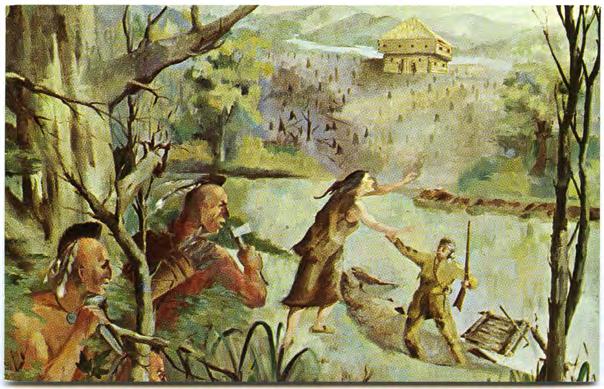
raft, floated it across the swift current, and brought Jenny to safety just minutes before the pursuing Natives arrived. Denied their quarry, they withdrew into the forest.
Jenny soon was reunited with Tom, and their lives began anew, with the subsequent births of five more children. The story of her capture and escape spread rapidly by word of mouth throughout the frontier settlements.
The Jenny Wiley saga has gripped the popular imagination, particularly of Kentuckians, since the late 18th century. As biographer Todd Pack relates, for years after the events, “When a mother cried, ‘Jenny Wiley!’ her children came running. Jenny’s name reminded them to ‘stay safe; stay close.’ ” Since the capture and escape were not consigned to paper in their entirety for more than 100 years, the details survived largely through oral tradition, passed down from one generation to the next. After such a long time, the story has attained a life of its own, until it is nearly impossible to determine the difference between fact and folklore.
There was, indeed, a Jenny Wiley. She was born Jenny (or Jean or Jennie) Sellards in 1760, possibly in Pennsylvania. Shortly after her birth, Jenny’s father, Hezekiah, moved his family to Walker’s Creek in Virginia’s Upper Clinch River Valley. It was in this frontier region, some 19 years later, that Jenny met and married an Irish immigrant named Thomas Wiley. The young couple built a
cabin near what is now Bland, Virginia, and began a life based on resilience and self-reliance.

Little is known of Tom Wiley’s early history, although it can be surmised that he left his native Ireland during the mid- to late 18th century surge of Scots-Irish immigration to the New World. Tom settled in Virginia in 1774, and the inscription on a recently erected memorial stone indicates that he served in the 1st Virginia Regiment during the American Revolution.
If Tom Wiley’s intention was to carve a life from the wilderness, he had chosen the best possible mate. As a son would later describe her, Jenny “had coal black hair. She was strong and capable of great exertion and endurance. She was of fine form, and her movements were quick. Her eyes were black with heavy overhanging brows. She was above medium height. Her face was pleasant and indicated superior intelligence. She was persistent and determined in any matter she decided to accomplish. She was familiar with woodcraft and was a splendid shot with a rifle.”
Jenny was, in fact, seized by Natives when Tom was away from the cabin on or around the first of October 1789. We know this from a letter dated Oct. 20 from Montgomery County Lieutenant Walter Crockett to Virginia Gov. Beverley Randolph. It reads, “On the first of this instant A party of Indians took one Willey’s [sic] family, killed and scalped foure [sic] of his children and took his wife and her youngest child prisoners.” She remained a prisoner until her escape, by which time she
had lost her two remaining children.
Jenny’s capture was far from unique. For centuries, America’s unsettled lands beckoned to those in search of fortune, adventure or simply the chance of a fresh start. However, life on the vast frontier was nothing if not perilous for the westering immigrants, with atrocities committed by both the Natives and the Europeans. According to biographer Pack, although original source material is understandably scant, it can be estimated that the settlers seized by Natives during America’s four centuries of westward expansion numbered in the tens of thousands.
The annals of the settlement of the nation’s borderlands are rife with tales of women stolen from their homes and families and introduced into lives of captivity in the various tribes. It often was a brutal life for a female captive, and many died as a result. Some had better luck than others and were traded or ransomed back to their families. Others staged daring escapes, preferring to face the elements rather than live among their captors. And there were some who simply accepted their lot, making the tribal lifestyle their own.
As documented in a July 4, 1790, letter to Gov. Randolph from Russell County Lieutenant J.D. Smith, Jenny Wiley’s life as a prisoner of the Natives lasted some five or six months, although the length of her captivity has been wildly exaggerated over time. One of her sons, born well after her return, erroneously claimed that she had remained with the band for nearly a year, as does a Johnson County, Kentucky, historical marker. William C. Pendleton’s The History of Tazewell County and Southwest Virginia, 1948-1920, published in 1920, has her living among the Natives for three years.
In addition to presenting a garbled, grossly inaccurate version of the attack on the Wiley cabin, Pendleton makes statements regarding Jenny’s experience that are patently false. In one sentence alone, he not only misquotes the date of her escape by more two years, but he also gives her a young traveling companion: “In September 1792, she made her escape in company with Samuel Lusk, a youth some sixteen years old.” Pendleton has the pair fleeing 50 miles down the Scioto River in a canoe that Lusk had secreted for the escape, then taking refuge in a village of friendly French immigrants. A youth named Samuel Lusk was, in fact, captured by the Shawnee tribe but a full two years after Jenny Wiley’s bid for freedom. One thing is historically certain: When Jenny fled, she fled alone and without a boat.
To further muddy the waters, Jenny’s story often was confused with that of another captured pioneer woman. Mary Draper Ingles, who has been touted as the first white woman to settle in the “Can-tuck-ee” wilderness, was taken by Shawnees in 1755, a generation earlier than Jenny’s abduction. She soon eluded her captors in what is now Boone County, Kentucky. Unfortunately, when
recounting the saga of Jenny Wiley’s dramatic escape, various second- and third-generation storytellers inadvertently melded the two women’s accounts.
In his old age, Jenny’s son, Adam Brevard “Vard” Wiley, told his version of his late mother’s story to a young schoolteacher, who recorded it years later as it was related—including the dates— with no thought given to the vagaries of memory, the biases of the narrator, or the passage of time. “In all matters concerning Mrs. Jenny Wiley,” the teacher dutifully wrote, “I have followed the account given me by her son … I believe it was sound judgment to do so.”
Considering it was not until a century after her escape that Jenny’s story was committed to paper from the “recollections” of people who were not yet born when she was captured, it must be assumed that confusion and embellishments played significant roles in what one chronicler has termed the “most romantic history” in the region’s settlement. As the conflation of Jenny’s, Lusk’s and Ingles’ experiences indicate, the significance and impact of oral tradition cannot be overstated. With the passage of time, all details that might interfere with the telling of a good tale get winnowed out as new “facts” are introduced, until the account is burnished and made suitable for optimal dramatic presentation.
This is not to minimize Jenny’s ordeal. It was, without question, unimaginably horrific. To witness the violent deaths and desecration of all six of her children is a horror too terrible to contemplate, nor did it leave her mentally unaffected. According to the son of a family friend, who knew Jenny in later life, “[S]he had little mind since her return from captivity.”
After her escape, Jenny returned to Walker’s Creek, where she and Tom soon started a new family. Ten years later, they moved to the Levisa Fork of the Big Sandy, near the scene of her rescue, where they lived out their remaining years. Tom died in 1810, leaving Jenny a widow until her death in 1831 at 71. She lies on a hill in the small town of River (Johnson County) under a state-financed monument erected in 1965. The site of Tom’s grave is lost to history. In 2005, a basic stone marker was placed facing Jenny’s monument, carved with his name, birth and death dates, and Revolutionary War service.

Various novels, plays and purported biographies have been written about Jenny’s ordeal. Today, a stream she supposedly followed in her bid for freedom bears her name, as do the Jenny Wiley State Resort Park and Keeneland Race Course’s Jenny Wiley Stakes horse race run each April. Prestonsburg hosts the annual Jenny Wiley Festival and is home to the Jenny Wiley Theatre. The Jenny Wiley Association welcomes both relatives and nondescendants in their mission to preserve her history, and— in the words of chronicler Pack—“[H]er name has appeared on everything from a car dealership to a flower shop.”
Part fact and part fable, Jenny Wiley’s place is vouchsafed in the annals and folklore of Kentucky.
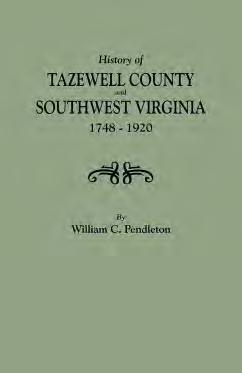



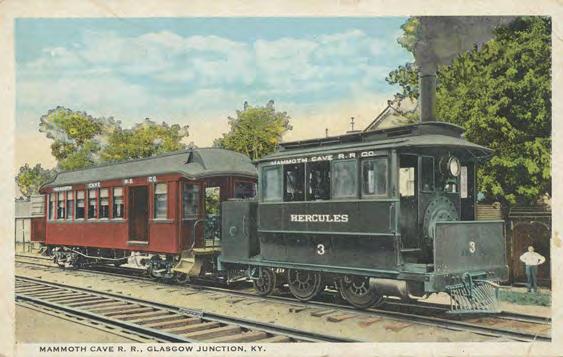










December has arrived, and in this issue, we have several stories reminiscing about holidays of yesteryear. I hope some of these memories bring back a few recollections for our readers, too.

I love to look at Christmas photos from my childhood to see the opened presents scattered all over the living room, reminding me of what Santa Claus brought that year. One of my favorites was the Christmas Eve when I was about 4 and my sister was 7. It was early evening, and we had some snow on the ground. My dad bundled us up, tucked us on a sled, and pulled us around the neighborhood so we that could look at Christmas lights. Mom stayed home to “shovel the driveway.”
When we got back home, Mom was hard at work, but she took a break to come into the house with us. As we came through the front door, we found the living room was a mess. Apparently, Santa had come, and he was in a hurry! There was candy thrown all around the room, presents were stacked up in giant plastic bags, and snowy boot prints were all over the carpet. There were even white wisps of his beard (which may have looked similar to pulled-apart cotton balls) strewn about. I could not believe Mom missed him, but she said she had been busy shoveling the driveway. It was a magical sight, and I can still picture it through my childhood eyes today.
What is your favorite Christmas memory? Was it because of a treasured gift you received? Or because of an event that took place? Send in your memories, and I’ll share them in next year’s December/January issue.
You can reach me at deb@ kentuckymonthly.com or mail items to Kentucky Monthly, Attn: Deb Kremer, P.O. Box 559, Frankfort, KY 40602-0559.
— DEBORAH KOHL KREMER
Letters may be edited for clarification and brevity.
The October 2022 edition of Kentucky Explorer featured “The Early Years of Fort Sequoyah” by Betsy Carloftis (page 70). It brought back memories of a refreshing rest stop on U.S. 25E during the 1960s, before I-75 opened in 1969. My wife, Pat, and I had married in August 1959 and “set up housekeeping” in Cincinnati, but we “kept the highway hot” on the weekends. Fort Sequoyah was a welcomed distance for a break en route to Pat’s hometown of Barbourville. I especially found the Cherokees residing there interesting.
We didn’t know any of the Carloftis family then, but we could have met Betsy as the 5-year-old shown in her article’s 1960 photo. She would have been too young to know that travelers entering the city limits of nearby Livingston had to be aware of its reputation as a “speed trap” to stay within the posted speed limits.

Spring forward to a 2005 home-and-garden show in Cincinnati, where we met Lucille Carloftis, who was helping her son, Jon Carloftis, market his new book, First a Garden. Lucille released a book, A Beautiful Journey, in 2007. One chapter titled “Diversity Among the Indians” describes the native tribes, in addition to the Cherokees, bringing their arts and crafts to sell.
With Jon Carloftis’ creative landscaping, Fort Sequoyah was transformed into the Rockcastle River Trading Company. On one visit, we met another family member, Buzz Carloftis, at the time the elected Rockcastle County judge-executive. The store was closed, but we traded a copy of my book Finding the Fifties for a jar of sourwood honey.
Each member of the Carloftis family I have met along the way quickly responded that they are great fans of my cousin Louie Dampier, one of the famed “Rupp’s Runts.”
Don J. Dampier, Lexington
Please
1.888.329.0053.
The holiday season seems to bring out the best in people. Acts of service, kindness and generosity are contagious and tend to envelop everyone in a wave of goodwill. Such was the case in Louisville in 1917. With the world embroiled in war, editors at The CourierJournal decided to start a club named the Christmas Cheer Club. They wanted to raise money to buy gifts for soldiers training at nearby Camp Zachary Taylor. The Christmas Cheer Club blossomed into something bigger than anyone could have imagined. For a short time in December 1917, a spirit of magic filled Louisville.
When the United States entered World War I in April 1917, military officials constructed 16 national Army training camps. One of them, Camp Zachary Taylor, opened in Louisville in June 1917. At any given time, some 40,000 soldiers trained in the camp. Citizens of Louisville were honored to host the camp and sought ways to contribute to the war effort.
In October 1917, The CourierJournal editors organized the Christmas Cheer Club and began planning a holiday celebration for soldiers. They figured it was not only their privilege but a patriotic duty. Much to their delight, the community embraced the idea. The excitement began to spread, and soon people across Kentucky and from as far away as Indiana and southern Illinois joined the Christmas Cheer Club. The spirit of giving filled the city as citizens donated money and supplies and hosted fundraisers. Even children got involved. The shared cause and shared sacrifice brought a sense of unity and joy.
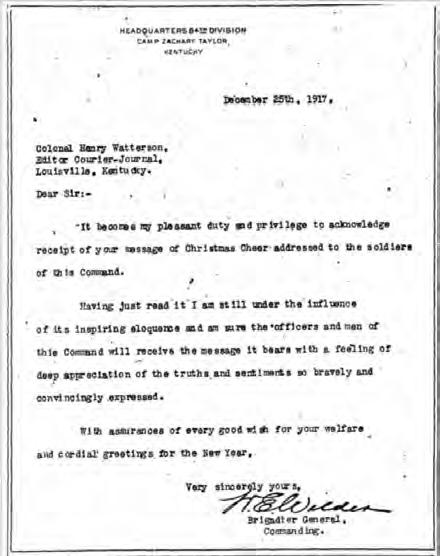
The Christmas Cheer Club established an ambitious goal to ensure that every soldier received a gift. The organizers also planned to donate 229 decorated Christmas trees for soldiers’ barracks and 36 miniature trees for the base hospital. To accomplish the planned celebration, volunteers wrote each soldier’s family, suggesting they send gifts to the club for
distribution. This would allow organizers to purchase gifts for those who didn’t receive any from home. Finally, they planned a Christmas dinner and party for the whole camp. Donations poured in. Busy volunteers worked long hours decorating trees, collecting gifts and organizing the celebration. When the Secretary of War announced in midDecember that soldiers in training camps would not be allowed Christmas furloughs, the mission of the club became more critical than ever. Gen. H.E. Wilder of Camp Zachary Taylor realized the importance of morale and appointed a committee of 15 military officials to assist the club with all arrangements.
As Christmas approached, volunteers worked frantically to complete the preparations. The offices at The CourierJournal were turned into a makeshift Santa’s workshop with hundreds of busy elves wrapping some 20,000 gifts. The soldiers awaited the celebration with the eagerness of children.

On Christmas Eve, volunteers filled delivery trucks with gifts and Christmas trimmings. Even though a cold rain fell, it couldn’t dampen the feeling of warmth and joy. The holiday convoy drove to the base, where volunteers joined the soldiers in a Christmas feast. Following dinner, the soldiers returned to their barracks and gathered around their brightly lit Christmas trees to sing carols. Finally, with anticipation building, volunteers distributed gifts to the soldiers. The feeling of joy was so profound that many soldiers choked back tears.
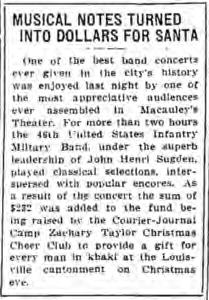
For all involved in the Christmas Cheer Club of 1917, “Christmas cheer” took on a whole new meaning. Camp Zachary Taylor was the only military camp in the country to participate in this type of Christmas celebration. Following Christmas, The Courier-Journal printed dozens of heartfelt thank-you notes from soldiers in the camp. Military officials and the War Department effused praise on the club, and the citizens of Louisville experienced the joy of giving.
Reprinted with permission: blog.newspapers.com/christmas-cheerclub-lives-up-to-its-name
Send your memory in today!
I was 6 in 1953, and when Christmas Eve arrived, I was so excited. I could hardly wait for the day to pass, but anyone who has ever lived on a farm with cows, chickens and pigs knows, we don’t take a holiday from the chores. The animals on our Marshall County farm needed care and feeding every evening and morning. The day had gotten much colder with the early twilight, and large snowflakes were beginning to fall.
My father and I walked up the low hill to the barn, and we knew as soon as we opened the door that something was wrong. One cow was in the wide central hallway, waiting to be turned into the milking stall, but our second cow was not with her. The milk cow was already mooing in distress because she needed to be milked. Daddy sent me to look for the other cow, who was going to have a calf soon. I went out into the small field behind the barn, where there were a salt lick and a water trough. I looked behind the corn crib and down by the pond, but I couldn’t find Blackie anywhere. We had named her Blackie because she had a distinctive black marking on her forehead, and I loudly called her name and said, “Here, cow. Here, cow,” over and over. I didn’t have on a cap, and snow was making my hair and my coat wet. I wondered if there was a little calf out there also getting snowed on.
I went back into the barn to report to my father. He had just finished milking and was putting the full pail on a high shelf, away from the greedy cats. He said that we would have to take the tractor and the wooden sledge and go look for the cow. He backed the tractor out of the shed and hooked the homemade sledge onto the back. The sledge was a wooden platform mounted on wooden runners, with an eye bolt on each side of the front. A chain was fastened to the eye bolts and looped over the hitch on the back of the tractor. It was an uncomplicated way of transporting bales of hay or other heavy loads.
We left the barn area. It was dark by then, and we peered through the falling snow to see if we could spot our cow. I rode between my father’s legs, warming up a little from his body heat. The farm was laid out one field after another, with a tree-lined lane running alongside. Inside the lane, the trees formed a canopy above our heads. We bumped our way down the dark lane, looking out into the fields and along the tree line. Finally, we spotted an irregular shape, and when my father called, Blackie answered with a moo. We jumped down from the
By Our Readerstractor and slowly walked over to Blackie. My father said that we shouldn’t startle her because she might be protective of her new calf.
When we got close, we could see a tiny calf on the ground. Blackie was standing over the calf, licking her. Blackie’s large body was blocking most of the snow from her baby. Daddy said that I should go sit in the middle of the sledge. When I had gotten into position, he lifted the calf and carried her to the sledge and my waiting lap. He lowered the damp little body, so I was able to wrap my arms around her. When he was sure that we were settled, he started the tractor and slowly headed back to the barn. Blackie followed the sledge, keenly watching her calf.
Our little procession was slow. The snow was coming down heavier now, and the ground was starting to turn white. I concentrated on keeping my bottom firmly planted in the middle of the sledge. There were no side rails or handholds. It was just me and the baby calf, heading back to the safety of the manger. I whispered calming words to her to drown out the sound of the noisy tractor, but somewhere along the way, the calf urinated all over both of us. I was surprised by the sudden warm wetness, but I held on, as I hunched my body over hers to protect her from the snow.
I didn’t even realize that we had made it back to the barn until my father lifted the calf off me and placed her next to her mother. After the calf had mastered her wobbly legs, Blackie led her baby into the barn, where fresh straw and feed were waiting for the new mother in the stall. I was stiff from the frozen position that I had taken, and my father had to help me stand up and move around. I was soggy and bitterly cold. After Daddy had latched the wooden gate to the stall, I stood on the cross slats to peer over the top and check on the mother and the baby. I was already trying to decide what we should name the calf.
When we got back to the house, everyone wanted to hear our story. I got a nice, warm bath in the galvanized tub on the kitchen floor and clean, fresh-smelling, linedried pajamas. After eating a bowl of soup, I went to bed, exhausted. I was hardly thinking about Christmas Eve. Instead, I was thinking about a mother and her new calf sheltering in the barn.
On Christmas morning, we were eager to see what Santa had brought. I quickly looked over what I had received, but my mind was elsewhere. As soon as I could, I bundled up and pulled on my boots. After a trip through the snow, I was proudly standing outside the stall of my calf, who looked warm and well fed.
It was the best Christmas present that I ever got.
During the 1950s and ’60s, my immeidate family and I were invited into the home of Russell and Willie-May Courtney every Christmas. Russell was my maternal grandmother’s brother. The Courtneys were a loving couple and always wanted us to visit for a Christmas get-together.
The table was set with seasonal foods, and our eyes were as big as our stomachs. The centerpiece was a revolving angel powered by four burning candles. Cinnamon apples colored red filled a dish every year. After two tables of guests were served, everyone retired to the living room for my favorite time: the
In Bourbon County, there were two presents every male child eventually found under the Christmas tree. One was a Daisy Red Ryder BB gun and the other a Zebco 202 rod and reel. For a boy living near Stoner Creek, with dense forest on both banks, they were highly prized and appreciated gifts.

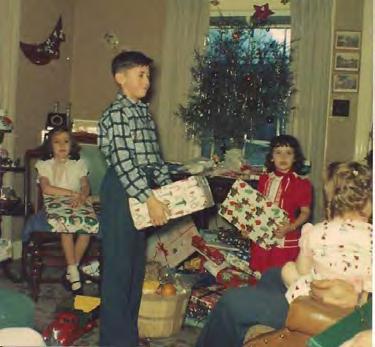
One day in 1961, I armed my 9-year-old self with my BB gun, a pocketful of Bazooka Joe bubble gum, and plenty of ammunition. I headed out to the forest to put meat on my family’s table, feeling like a young Daniel Boone
I sat quietly in the forest for a good hour and a half, thinking that if I so much as moved to scratch my nose or— heaven forbid—break wind, I would alert the entire residency of the forest to the fact I was locked, loaded and lying in wait.
After another 30 minutes of listening for a leaf to be disturbed or a branch to break, I decided I might have better luck if I climbed a tree. I had grown tired of sitting on the soggy ground, and I was extra wary of having ants crawl on me that I dared not move to swat off. I spotted a proper hunting tree nearby with low branches and lush green vines to use as ropes to pull myself up.
Not 10 minutes after I got situated, I spotted one of the biggest squirrels I had ever seen before or since sitting in the next tree over, enjoying a nut. I raised my gun slowly, deliberately and as steady as a brain surgeon who worked part time defusing bombs.
I lined him up in my sights, slowly took a deep breath, and held it. He stopped eating, then dropped his half-eaten acorn, and I swear he looked me straight in the eyes. I
opening of the gifts. Under the tree were baskets of fruit and nuts, presents all wrapped with ribbon and pretty bows. Scattered about in the branches were envelopes with the names of the recipients—mostly children. No child ever went without a gift of some sort. The Courtneys saw to that. To see your name on the tree or under it meant a lot of love had placed it there.
I am pictured in this photo with my sisters Rita and Janis. I think this was taken in 1959. I was 5 at the time, and I felt loved every year we returned to the Courtneys’ home. We were blessed, for sure.
Merry Christmas, everyone, and thanks for reading.
Christmas at the Courtneys’ home: Jerry and his sisters in the Lexington home of Russell and Willie-May Courtney.
was tasting the homemade squirrel stew with potatoes and carrots as I put pressure on the trigger. And then, nothing happened. I had forgotten to take off the safety. Luckily, this squirrel was either partially blind, deaf or both because he didn’t seem to notice when I made the necessary adjustment with my thumb and retook aim. Finally, with everything in order, I pulled the trigger. When I looked across the way, that squirrel sat undisturbed, and it seemed as though he might have been laughing at me as he hurried off to enjoy a long life.
As it turns out, BB guns aren’t all that powerful. Mine had a range of around 10 feet before you would see the projectile fall to the ground in front of you. The only thing it was good for was short-distance target practice. That is, if you didn’t set the empty can too far away and used ones that weren’t too heavy.
To add insult to injury, those convenient vines that grew up the tree trunk turned out to be poison ivy. I missed a week of school with a red rash that covered my body and caused me to go through two family-sized bottles of calamine lotion.
Some people turn out to be hunters and others fishermen. In my case, it was neither. I guess that’s why in the end, I traded my gun for a guitar. But that’s a story for another day.
In the summer of 1965, descendants of Atwood Hobson stood next to a hole in the floor of a second-floor bedroom in the family home. They could peer all the way down into the basement and survey the damage caused by a fire the previous winter. The abandoned home—its windows boarded and the grounds overgrown—gave few hints of its 19th-century grandeur. The reluctant conclusion of the family was that Riverview at Hobson Grove was beyond repair. Thankfully, fate had other plans.

Today, visitors from around the world come to Riverview at Hobson Grove Historic House Museum to learn about its association with the Civil War, the family who called it home, and the impressive restoration carried out by the first board of directors 50 years ago.

Atwood Gaines Hobson, having acquired 400 acres of farmland on the outskirts of Bowling Green, began work on his estate in 1857. Handmade bricks were fired on the site, and the walls of the home’s basement began to take shape. However, with the start of the Civil War, progress halted. Hobson, a strong Union supporter, thought quickly when Confederate forces took control of Bowling Green. Hobson sent a message to Confederate Gen. Simon Bolivar Buckner, who had served in Mexico with his brother, Edward Henry Hobson, and asked that the partially built house be spared. Buckner put the structure to use as a
Join in for the celebration of 50 years of Riverview at Hobson Grove with a candlelight tour on Saturday, Dec. 10, 4:30-7:30 p.m. Costumed docents will take visitors back in time to learn about Victorian Christmas traditions as they move throughout the home beautifully lit by candles and antique lamps.
This tour is free to the public, although donations are appreciated. Parking will be at the bottom of the hill at the ballpark and golf course, with shuttles provided to Riverview. The gift shop will be open, and complimentary refreshments will be provided. Guests can purchase a souvenir photo of their group.
munitions magazine and had soldiers stationed on the property. After the war, the Hobsons vied with other Bowling Green citizens for building materials. Because of the shortage, the home wasn’t completed until 1872.
The Hobson farm became noted for its Thoroughbred horses. Although Thoroughbred farms typically are associated with the Lexington area, the Hobsons ran a successful operation in Bowling Green.
For nearly 80 years, children, grandchildren and greatgrandchildren enjoyed gathering in the home. Atwood and Juliette Hobson’s youngest son, George, left the property in 1950, when he was in his mid-80s. Following the family’s departure, Riverview at Hobson Grove was home to tenant farmer families. During this period, the house fell into serious disrepair, and water from a leaking roof caused a great deal of damage to the decoratively painted plaster parlor ceilings, once the showpiece of the home. The old Hobson House, its plaster crumbling and roof leaking, still did not have electricity and proper indoor plumbing. A gentleman from Franklin (in Simpson County) purchased the property to farm the 400 acres and tried to present the home to his niece as a wedding present. Seeing how much work the structure needed, she declined his offer.
Scheduled tours of the Riverview at Hobson Grove are available through Dec. 10. They are given on the hour, Tuesday-Saturday, 10 a.m.-3 p.m., and Sunday, 1-3 p.m.




Riverview at Hobson Grove | 1100 West Main Avenue | Bowling Green | 270.843.5565 | bgky.org/riverview
In October 1965, the city of Bowling Green purchased the dilapidated house for $1 and acquired 200 of the family’s 400 acres to form Hobson Grove Park and Golf Course on the west side of town. Riverview at Hobson Grove was to be demolished to make way for a new golf course clubhouse. However, local citizens with family and social ties to the house—including Atwood and Juliette’s granddaughter, Margaret Hobson—banded together to form the first Hobson House Association board. Their purpose was to save the old home and run it as a historic house museum. In 1966, the city of Bowling Green received a United States Department of Housing and Urban Development grant for half of the restoration costs. The remarkable group of citizens who formed the first board spent 1966-1972 raising funds and fully restoring Riverview at Hobson Grove to share with the public. Because of their efforts, Riverview at Hobson Grove Historic House Museum opened in 1972, 100 years after the Hobson family moved into their showplace next to the Barren River. For 50 years, it has been a great joy to share this historic treasure with visitors from around the world.
Set within a tranquil city park, the Italianate-style historical house museum greets visitors from its perch on Hobson’s Hill. Among the first features guests will observe are the arched windows and doors, deep bracketed eaves, and a cupola atop the building. The cupola served a clever purpose in the Hobson home. On hot, humid summer days, the symmetrical windows and doors could be opened for cross breezes, and the hot air would be sucked up into the cupola and out its opened windows. The home includes two parlors, a dining room, a study, four bedrooms, a water closet and a full basement, where the original kitchen was housed.
While building the home, Atwood Hobson met itinerate artist Fritz Leiber and invited him to paint the plaster walls and ceilings of the mansion’s front and back parlors. Extensive restoration work in the past two years has brought these rooms back to their original splendor. Using a combination of historical photographs, sanding and paint removal, the talented restoration artist has mapped and recreated the striking designs on the ceilings and walls to recreate what Atwood and Juliette Hobson would have enjoyed 150 years ago. Additionally, Leiber used similar techniques to restore the decorative wood graining in the two parlors, which now mimics walnut and birdseye maple, as it did in 1872.
When you think of shooting matches today, you might think of the fall months, when the VFW or the American Legion sponsored ham or turkey shoots. You showed up with your weapon, paid your fee, and shot at targets. Whoever shot closest to the mark got the prize. When Gary Cooper played Sergeant York in that classic movie filmed in 1941, he shot at the target to win the beef. That didn’t happen on Big Willard Creek in Perry County in the 1950s. No, we shot poultry and game birds.
One match that comes to mind is from Thanksgiving Day 1954. Arnold Turner, who lived about a half-mile down the holler from me, decided he would hold a shooting match. News about the event was spread by word of mouth, and on that frosty Thanksgiving morning, about 15 men showed up to exhibit their shooting prowess. They shot with .22 rifles.
The targets would be hen pheasants or chickens. Anyone who had one could bring it and put it up as a target. Hens cost a nickel a shot and pheasants a dime, with the owner collecting and keeping the money.
Arnold’s place was a natural for shooting. His house sat where two mountains came down close together with a bench on either side. For those of you who don’t live in the mountains, a bench is the point where the mountain halts its rapid descent and levels off to a flat area before quickly descending again to its bottom, usually occupied by a creek.
On that day, the shooters stood on one bench and shot at the game on the other bench, a distance of approximately 150 yards. To make it fairer, the chickens or pheasants were staked out with a 10-foot string tied to a leg so they could move around. Many readers will think this unimaginably cruel by today’s standards, but this was the 1950s, and our society has changed considerably.
My friend Bill Turner, Arnold’s son, and I took care of
the targets. We would stake out the bird, go around the hillside and get behind rocks so a ricochet wouldn’t hit us. After each shot, we would check the bird to see if it had been hit. It took blood in the feathers to win it.
Walter Turner, Arnold’s brother, brought a half dozen pheasants he had raised. Hen pheasants are small and naturally camouflaged, so I figured they would be difficult targets. Walter thought so, too, and was hoping to make some money. Not so. I don’t think it took more than five shots for either of them, and Walter was not a happy fellow.
The morning progressed with everyone but Walter having a good time. By noon, most birds were gone. It was then that Arnold put forward a big fat hen. It was a White Rock and stood out against the brown grass on the bench. It made a great target, but nobody could hit it! It seemed impossible considering how quickly the men hit the other birds. They bought two shots, three, five and even 10 but without luck. Arnold collected more than $13 from that hen and couldn’t believe it. That’s a lot of nickels!
All those men were excellent shots, and I think that before long, they gained respect for that hen and its ability to survive. They were laughing and joking about their inability to hit it. But time wasn’t on the hen’s side. My father came walking down the holler with his .22, an older model he had traded for a railroad pocket watch. It didn’t have any way to adjust the rear sight—that piece had been lost years ago. He used a dime and a penny to set it, bought two shots, and shot its head off on the first shot. I would agree it was a lucky shot, but Dad was an expert rifleman for 23 years in the Army. The Army pays men extra for expert shooting, and Dad always got it.
It has been almost 70 years since that Thanksgiving Day. Almost all the participants are gone, but seldom a Thanksgiving Day comes around that I don’t think of that shooting match, the men who participated, and, yes, the $13 hen!
The Renfro Valley Barn Dance was a stage and radio show that got its start on Oct. 9, 1937. It was held at Music Hall in Cincinnati and was broadcast on the 50,000-watt WLW-AM in Cincinnati on Saturday nights. In November 1939, the show was moved to this barn near Mount Vernon in Rockcastle County.

Covington-born artist Frank Duveneck (1848-1919) reached a peak of international fame in the art world in the latter decades of the 19th century. The 1888 death of his wife, Elizabeth Boott Duveneck, a turning point in his life, induced him to return to his family’s Kentucky home on Greenup Street.
Duveneck’s artist friends pestered him to stay in New York, Boston or Europe, where he had founded two schools. He responded like a frugal, fun-loving Dutchman. Studio prices in Covington, he wrote, were one-fifth of those elsewhere. He replied to another, “Next week begins the horse races, which are always exciting and interesting here and with baseball and good whiskey in addition, we ought to manage to get along.” His mother, whom he revered, pioneer Katherine Siemers Duveneck; his halfsister, Mollie; and other siblings offered him the warmth and charm of a loving home.
In the art center of Florence, Italy, the Duvenecks lived the high life. He and Elizabeth’s residence at Villa Castellani served as a centerpiece for luminaries such as Elizabeth’s friend, the author Henry James. His own acclaimed circle included James Abbott McNeill Whistler and John Singer Sargent. His students, a rascally talented crew known as the Duveneck Boys, were the toast of Florence. America’s dean of writers, William Dean Howells, was so taken with Duveneck and his students that he fictionalized them as the Englehardt Boys in his 1886 novel Indian Summer.
Elizabeth’s death from pneumonia during a temporary move to Paris left the artist devastated, the father of a 2-year-old son, and wealthy from her estate as a New England textile heiress. He quit teaching and devoted his time to creating an effigy of his wife. Apart from the prizewinning Rembrandt-like canvases he had produced as a student in Munich, the sculpture of Elizabeth in its several forms is his most recognizable work. Versions are featured today in the Museum of Fine Arts, Boston, and in the Metropolitan Museum of Art in New York. The first copy of the clay form is a highlight of the Duveneck Room in the Cincinnati Art Museum. Most prestigious, though, is the bronze version above her grave in the Cimitero Evangelico agli Allori in Florence.
The life and career of this sensitive, talented, heartbroken man changed drastically during the decade of the 1890s.
Choosing to stay at home meant being close to family problems. Mollie, a frequent model, had an affair with a married man, a coal dealer from Pittsburgh. Frank’s mother, a devout Catholic, asked him to intervene. He wrote letters to Mollie pleading for her to end her fling. (Letters from Duveneck and the coalman were found in a cigar box hidden behind a brick on an attic staircase in the Duveneck home.) After one relapse, she eventually consented and became “home daughter” to her mother and major-domo for Frank’s domestic needs.
At the turn of the century, Duveneck resumed teaching
at the Art Academy of Cincinnati. He was a well-known figure riding the streetcar through Covington to the academy. During this period, he firmed up a connection with Boston where his son, Frank Jr., was being reared by Elizabeth’s relatives. He spent summers in Gloucester, Massachusetts, and painted seascapes in a shift to Impressionism. For this reason, Duveneck is regarded as a Boston painter. His sculptures of former Harvard University president Charles Eliot and writer Ralph Waldo Emerson, owned by the university, are on display today in Cambridge.
In the first decade of the new century, Duveneck completed a three-paneled mural commissioned by Bishop Camillus Maes for the Blessed Sacrament Chapel of the Cathedral Basilica of the Assumption in Covington. Duveneck dedicated the triptych to his mother. The grayhaired figure in the middle panel who kneels at the foot of the cross resembles his mother, whose portrait he painted numerous times.

Duveneck’s greatest recognition came at the 1915 Panama-Pacific International Exposition in San Francisco. Thirty Duveneck oil paintings, 13 etchings and a replica of his memorial to Elizabeth stole the show on display in the main entrance of the Fine Arts Palace. A jury of international peers went on record recognizing “his distinguished contributions to American Art” and struck a medal in his honor.
Covington is proud of its famous son and honors him on a triangleshaped hub near the center of town referred to as Duveneck Square. A bronze statue of Duveneck holding a portrait of Elizabeth by local artist Matt Langford dominates the memorial setting.
Read more about the artist’s life in The Greatest Brush: Love, Tragedy and Redemption of Artist Frank Duveneck, by James Ott.

“In the long run, you make your own luck—good, bad or indifferent.” Loretta LynnPainting by Duveneck at the Cathedral Basilica of the Assumption in Covington.
It was a cold winter night in November in the coal mining community of Bonny Blue, Virginia, when Daddy came home from work with the unexpected news: We were moving to Kentucky.
Thanksgiving was approaching, and signs of Christmas were beginning to appear in store windows. There was much worry mixed with holiday plans that year. The Japanese had bombed Pearl Harbor on Dec. 7, 1941. Congress issued a declaration of war against Japan, and President Franklin D. Roosevelt signed it shortly thereafter. Thousands of American troops were spread all over Europe and Asia. We were in the midst of World War II. Loud sirens often pierced the silence of the night. When this happened, all the lights in the entire community were turned out, and dark shades were drawn in the event an enemy plane flew over our village. Without lights, there would be no easy target to bomb. Most factories were turned into production plants to make tanks, planes and weapons for the war.
As a result, families were asked to sacrifice. We had stamp-ration books to get shoes, sugar, meat and many other items. There was a teacher shortage, also due to the war. As a result, I went to first grade for only a half-day, and now I was in second grade, also for a half-day. My sister, Doris, was 9 and in the fourth grade. Our brother, Gene, was 11 and had just begun sixth grade. I loved my school, and I loved Bonny Blue.
onto a large truck and covered with tarpaulins in case of rain. The family then climbed into our old 1937 gray Ford along with another man who needed a ride to his new job in Kentucky.
An unspoken fear began to grow inside of me. With Christmas only four weeks away, would Santa know where to find me? I was so afraid to ask anyone because everybody seemed too worried about other things. Would our old car make the journey? How lonely would it be in the mountains? Would the war be over soon? Would Uncle Delbert in Germany and Uncle Clarence in England be OK? We already had lost a cousin, Clayton Bays, when Pearl Harbor was bombed. And what about school and stores?
My fears grew as we continued that long journey over many mountains. What if there was no Santa? We grew hungry, but we could find no restaurants or stores on the mountain roads.
We finally found a small gas station that had some snacks and Cokes. This was a great relief but did nothing to erase my greatest worry. Why were we going so far away through these lonely, desolate woods?
Vintage Christmas card from 1944 with flocking on Santa’s hat and mitten.

Late in the afternoon, Daddy announced that we were only 12 miles from our new home. But things began to get worse. We no longer traveled on a blacktop road. We were bumping along on a rut-filled, dirt road. The old Ford moved at a slow pace. Mama was crying. Doris, Gene and I became silent. We dared not complain. And then, those last few miles got really bad.
I had a big yard and friends who came to play. Now all of that was going to change. Daddy announced to the family that Blue Diamond Coal Company was opening a new mine in the Appalachian Mountains of Kentucky. He was being sent there to help the mine get started and eventually be the tipple foreman. We would move soon.
The entire family remained quiet that night. Our family didn’t talk about feelings in those days. But you could sense the gloom enveloping them. Mama was 40, and Daddy was 44. Mama was worried about bringing us up in the wilderness in a place called Leatherwood (Perry County). We knew at an early age that education was important. Doris had begun piano lessons and was doing quite well. She practiced endlessly on the big upright piano that our grandfather had given to Mama before she married. I tried to imagine what life might be like in Kentucky. None of us dared ask questions, as we knew it would sadden Mama even more.
Finally, moving day arrived. Our furniture was loaded
There was no road at all. We sometimes were traveling up rugged creek beds. The mountains got higher and denser. There was a graded place where the railroad track was being laid, and that’s how we trudged through the last 5 miles. It had rained, and there was nothing but kneedeep mud. Daddy had to somehow find a bulldozer, and this was used to pull the truck full of furniture for the remainder of the trip. Mama, Doris, Gene and I were put out of the car and into the mud. It was difficult to get our little legs to move through the deep mud. But on we went, with my little mind filled with worries.
By the time we reached our new home, it was dusk, and anything would have been a welcomed sight. There it was: our little four-room frame house covered with imitation brick siding. There was a small outhouse about 50 feet up a hill. We had cold running water. Our heat came from a huge range in the kitchen and another stove in the living room. Both had to be fed constantly with coal and wood. Water for baths and washing clothes had to be heated on the stoves.
We had one neighbor—the Grahams, who had a son named Jimmy. I was so glad to see him. At least I would have one playmate.
Leatherwood was not yet a village. There were three bunkhouses for the miners and a tiny company store with only the bare basics of food. A truck came once a week, if weather permitted, to bring supplies. Milk and meat were rare luxuries. The nearest town was Hazard, which was 36 miles away. There would be no school for a year, no church, no drug store, and not even a doctor. There we were: two little families nestled in for the winter in the highest mountains of Kentucky. We were so far away from our beautiful Virginia. How would Santa ever find this forgotten, forsaken place?
As the days went by, we learned that it was exciting to explore the mountains. Mama and Daddy made sure that we read books and did our lessons around the large kitchen table. At night, we listened closely to the Philco radio. The news of the war was of utmost importance but now seemed so much farther away. Kate Smith, Bing Crosby and Gene Autry sang my favorite Christmas songs—”Silent Night,” “White Christmas” and “Rudolph, the Red-Nosed Reindeer.” We spent hours looking at the Sears catalog, wishing, hoping and worrying.
One day, Mama got us all dressed in our warmest clothes and announced that we were going to Hazard. We were thrilled! Finally, a real town again! It took hours to get there over the rough roads. How distinctly I remember wandering all over the Woolworth’s Five and Dime with wide-eyed excitement. We made purchases of hard, colorful Christmas candies and preserves. These would be carefully packaged and sent overseas to Uncles Delbert and Clarence. They had remembered us with packages, even though they were in the middle of the war. We also got tiny letters from them that were read and photocopied by the State Department because there was a danger of spies. Mama always cried when she read the letters.
Christmas Eve was a cold, snowy day. My eyes searched the skies with wonderment all day. Doris and Gene didn’t seem to share my deep worry about Santa. Mama had been able to get sugar to make peanut-butter fudge, peanutbutter rolls and large doughy cookies sprinkled with sugar. These were rare treats with war rationing. Our little tree stood brightly in front of a window. We had gone out into the woods with Daddy and carefully chopped it down. We were so proud of how pretty it looked. We found our best
KENTUCKY EXPLORER MAGAZINE (1986-2020) all 344 issues, over 34,000 pages now for sale in digital format. Visit kyexmag.com for ordering details. If you enjoy Kentucky history, genealogy, and much more, visit kyexmag.com (O-D)
SELF-PUBLISHING: On-Demand Book Printing, Softcover, Hardcover, and Spiral Binding, Side-Sewing for Children’s Books, Kindle Books, Typesetting, Editing, Graphic Design, Amazon Listing, BibleRebinding, etc. Contact Reformation Publishers, Inc., DBA 24-Hour Books, DBA Williams Printing Co., 14 S. Queen Street, Mt. Sterling, KY 40353, Email: rpublisher@aol.com, 1.800.765.2464, Telephone 859.520.3757, Fax 859.520.3357, Text 606.359.2064, www. reformationpublishers.com. (F-D)
clean stockings and laid them hopefully on a chair for Santa. I pressed my face against the cold, dark window and took one last look at the December sky. Then, we were sent off to bed. I waited and worried and listened until I finally dropped off to sleep.
On Christmas morning, we were awakened to the strong aroma of coffee brewing, homemade biscuits baking, and gravy simmering on the kitchen stove. I could hardly wait to bounce out of bed and run across the cold linoleum floor. Would there be something? It didn’t even matter what. Just please, please—would there be something? Did Santa come to our house? Relief rushed over me as my fears slowly faded away. There was a Santa Claus! And he found our house in the mountains after all!
There were three little piles of gifts—one for each of us. Doris, Gene and I immediately knew which gifts were ours. There was my beautiful doll, a little set of green glass dishes, paper dolls, a coloring book, mittens and wonderful books. The Bobbsey Twins books were were for me; Nancy Drew mysteries were for Doris. Gene received Lassie ComeHome and Zane Grey and Hardy Boys books. Doris also had a doll and other gifts. Among Gene’s presents were a Red Ryder BB gun and a Monopoly set. Our stockings were filled with apples, nuts and candy canes. Christmas was glorious after all!
Many years have passed since that Christmas morning, but I can still remember the relief felt by that little pigtailed, freckle-faced girl named June. We spent the rest of our growing-up years in those mountains. We even grew to love them and fondly remember them as our home. I don’t think there is ever a Christmas that goes by that I don’t remember my first year in the rural Appalachian Mountains of Kentucky.
June Querry Miller is a retired public elementary school teacher living in Dallas, Texas. She received her teaching degree from Cumberland College (1957 and 1961) and began her teaching career in Leatherwood, where she had attended just years earlier. After her marriage to her college sweetheart, who was in the Air Force and then became a federal agent for the United States Treasury, she moved to many locations in the U.S. and finally resided in Dallas, where she retired from Plano Independent School District more than 30 years ago
WANTED TO BUY: All types of antiques and collectables. Top prices for gold, silver and costume jewelry. Scrap gold. Gold and silver coins. Wrist and pocket watches. Collections. Early post cards and fountain pens. Civil War swords and other military items. Vintage toys. Pocket knives. Lighters. Old eye glasses. Pottery and stoneware. All types of railroad items. Advertising signs. Handmade quilts. Marbles. Jars. Much much more. Complete and partial estates. Call Clarence, buyer for more than 30 years, at 606.531.0467. (F-D)
Reach 120,000 readers with classified advertising available in Kentucky Explorer. Classified ads $50 per issue (up to 25 words). Contact Deborah Kohl Kremer at deb@kentuckymonthly.com.
At this late stage in my life—I’m 82 and counting— it is important that I explain the evolution of my thoughts on race, as it will apply to many of my readers. I wrote the following essay as a 10- or 11-year-old student at Northside Elementary in Shelbyville about 1951 or so.
Negro[e]s can go to the movies but must sit in the balcony. They can use our courts. They have their own schools, churches, and parks. They have their own hospitals. They can ride on trains and buses. They have their own restaurants and hotels. I[n] larger cities we use the same hospitals. I[n] Louisville they have their own parks. I think that if [we] get friendlier with them we won’t have as much trouble.
I then listed several “Prominent Negro[e]s,” including singers, baseball players such as Jackie Robinson, boxers Joe Louis and “Sugar Ray” Robinson, and some scientists, concluding with educator Booker T. Washington
My final sentence was a telling comment of the shortsightedness of my generation: “The Supreme Court has upheld the civil rights of Negro[e]s.”
This all seems so childish today. And yet, it has taken 70 years of reading, listening, watching, working, teaching and thinking to produce what I am today.
I recall being around African-American farmers and workers at my father’s business, Ellis Welding and Brazing Co., on Clay Street in Shelbyville. My father always treated them equally with the more numerous white farmers.
I have written before about being a “helper” to a handicapped Black man, whose only name I knew was “Trout.” I begrudgingly assisted him when he crawled under our little frame house on Snow Hill outside of Shelbyville to dig out dirt with a grubbing hoe for what would become our basement.
I was 10 at the time, and my job was to remove the dirt that Trout laboriously pushed through an opening in the foundation. I would have preferred to be reading “funny books” under a shade tree. He would call, “Water! Water!” and I would—again, following my father’s orders—give the man cold water from a jug.
If and when I get to heaven, I hope to meet up with Trout and apologize for my ill-mannered behavior toward a poor working-class Black man. Perhaps we can share a cup of cold water together.
• • •
I recall the derogatory names for African Americans, the racist jokes, the separate rest rooms in the courthouse, and knowing that Blacks could sit only in the balcony of the movie theater. It was all part of the natural order of things, we thought.
The 1954 Supreme Court case Brown v. Board of Education slowly began to change America.
I graduated from a segregated school system in 1958 and attended Georgetown College, which desegrated near my
senior year in 1962. I belonged to a Southern-style fraternity and had no African-American players on my football team. I attended a segregated Southern Baptist church.
Only—and I emphasize only—did my innocence of the racial dilemma in Kentucky hit me when I taught high school history and coached the 1962 Harrodsburg High School football team. About a fourth of the team were Black kids. I remember well being told at a famous Richmond restaurant that I could not bring all of the players in for a post-scrimmage meal on a hot August night in 1962. Twenty-two-year-old Coach Ellis became enraged. Welcome to the real world, Coach!
Later, we all were welcomed at a Jerry’s Restaurant. As we left the restaurant, some local white guys—clearly drunk—tried to create an incident, but Assistant Coach E.G. Plummer and I backed them away from the team.
One of my players on that team, Larry Barnett—who later served in Vietnam and enjoyed a successful career in education—recalled conversations he had with a Black classmate who was part of the transition to desegregated schools. “ ‘Larry, you will never know the fear that we had leaving Westside and coming to an all-white high school,’ ” one student said to him. “She gave me a perspective I had not dreamed about,” recalled Barnett.
Integration proceeded smoothly in some places and not in others. Busing in Jefferson County gained national headlines, as did the integration of neighborhood housing. • • •
White and Black, we all have a story.
African-American student Aaron Thompson had a traumatic transition. In 1965, “I went from an all-Black three-room school, where the teachers cooked our lunch on the stove and [we had] an outhouse for a lavatory, to a newly constructed elementary school that had a cafeteria and an inside toilet,” he recalled. “Being from the county [Clay], there were only four of us Black kids in that school. In the first year of my new school, every day was a bombardment of racial slurs and threats of violence. Every day was a time I could expect to be held by boys in the bathroom while one would hit or spit on me. I could be expected to be accosted on the bus.”
Teachers protected the young boy when they were present. “Toward the end of my first year,” Thompson said, “I started to fight back, and I fought hard. I was a good-size kid, and I learned to use the size of my body to adjust to my new environment. Although the first year was a time of me being afraid, school became a place I conquered and loved.”
Now Dr. Aaron Thompson, the president of the Kentucky Council on Postsecondary Education, he has had a long career in education. He did, indeed, come to love education and its benefits for all Kentuckians.
What is your story?
Readers may contact Bill Ellis at editor@kentuckymonthly.com
She was one of the most popular of a long list of Miss Americas. She had natural beauty, down-home charm and an intense focus on career goals. Those attributes served Phyllis George well—so well they allowed her to do her part to “shatter the ceiling” of resistance to women moving forward in previously gender-determined roles.
Authors Paul Volponi of New York and Lenny Shulman, who lives in Nonesuch (Woodford County), share an illuminating look at the first woman to regularly appear on a national sports show. But there’s much more about George’s dynamic life, which ended on March 14, 2020, from a blood disorder.
In Phyllis George: Shattering the Ceiling, readers learn of George’s close relationship to her mother, her diverse television opportunities, her passionate social initiatives, the “Camelot” experience of her marriage to John Y. Brown Jr. and serving as Kentucky’s first lady, plus behind-the-scenes stories of a woman confronting blatantly chauvinistic behavior. Strong and affable, she stood tall to the end, even as she fought the ravages of her terminal illness.

The book leaves us with what we always thought about George, a treasured soul who made us proud she became a part of Kentucky.
By Steve FlairtyPhyllis George: Shattering the Ceiling, by Paul Volponi and Lenny Shulman, University Press of Kentucky, $27.95 (H)

Louisville is a city steeped in fascinating history. This book starts, as Louisville did, at Corn Island, the Falls of the Ohio, and the 1780 act by Virginia Legislature that established the town. The chapters of this 190-page book, filled with many photos, are arranged in chronological order by era and include the steamboat age, the rise of railroads, and the war years.
Through each era, author Bryan S. Bush takes readers to specific locations—many that still can be visited today—to introduce why it is important historically as well as what visitors can see there. Places such as Cave Hill Cemetery, the Louisville Water Company Pumping Station and Farmington Plantation are a few favorites.
Bush, who resides in Louisville, has written many books pertaining to history, particularly the United States Civil War, and he frequently contributes to the Kentucky Explorer section of Kentucky Monthly. He is the park manager of the Perryville Battlefield State Historic Site in Boyle County.
By Deborah Kohl KremerMiddle-aged Dave Wertz would just like to get along with life, but it’s not happening. He’s lost his job, is not relating well with his wife and son, and had grown up with a bad connection to his own father. Baggage firmly on his shoulders, he goes on the road seeking to find himself, albeit a relatively short geographical distance—from Lexington to Frankfort.
And what the mixed-up sojourner encounters is the subject of another compelling Chris Helvey novel, Into the Wilderness. It’s a pageturner.
The individuals Dave meets in his personal wilderness have their own serious problems. First, a lifelong friend he thought trustworthy has changed. An eccentric but kind street preacher gives off mixed signals to Dave about soul redemption. A young homeless woman living under a bridge is treated with treachery by those without a conscience. Not ironically, Dave also meets a corrupt politician.
So where does Dave turn for meaning, or—at least—some modicum of solace to his tortured soul? That’s the question that Frankfort resident Helvey craftily answers in his narrative, and in so doing, he continues to demonstrate that he is one of Kentucky’s finest writers.
By Steve FlairtyInto the Wilderness, , by Chris Helvey, Wings ePress, $15.95 (P)

Raised as an only child in the tiny community of Natlee in Owen County, a young girl carefully observed her surroundings and took mental notes. She held on to those memories tightly. In Georgia Green Stamper’s newest book, Small Acreages: New and Collected Essays, she craftily demonstrates that “the wise country people who raised me continue to remind me to pause and laugh at myself and the world in order to remain sane.” For her writing, it seems that all roads lead back to Natlee, her kin and the neighbors.
Included in the 59 memoir essays, each written with at least a touch of lightheartedness, are “Uncle Murf,” a man both inspiring and perplexing; “Father’s Day 1954,” a riveting story of being sneaked by her father into her dying grandfather’s hospital room; and “I’d Give a Hundred Dollars,” in which readers discover what doesn’t work for entertaining bored and restless children sitting in the back seat of a car on a long trip.
As always, Georgia’s writing both entertains and gently sneaks in life lessons. She portrays such with a clarity that sets her squarely amongst the finest in the state’s literary landscape.
By Steve FlairtySmall Acreages: New and Collected Essays, by Georgia Green Stamper, Shadelandhouse Modern Press, $23.95 (P)

Daniel Boone is claimed by both Kentucky and Missouri as one of their legendary frontiersmen. He obviously had adventures in each of the states, but when he passed away in 1820, both states wanted him buried within their borders, so the grave could attract tourists.
Frankfort, which did not have a cemetery at the time of Boone’s death, wanted both Daniel and his wife, Rebecca, to be laid to rest in the Bluegrass State, and locals spent a few years trying to finalize a deal to bring his body back to Kentucky from the Show-Me State, where he had been buried.
Daniel and Rebecca’s remains were brought to Frankfort in 1845, but some Missourians question whether the move ever took place. Author Ted Franklin Belue of Murray explores the topic in depth and brings it to a conclusion.
Belue has edited two biographies about Boone, has written several history books, and includes information regarding the frontiersman that might not have been published before.
By Deborah Kohl Kremer
Finding Daniel Boone: His Last Days in Missouri and The Strange Fate of His Remains, by Ted Franklin Belue, The History Press, $23.99 (P)
Drawing from the fertile memories of her life and family experiences, Linda Hawkins offers uplifting stories, poems and inspiring quotes in On the Wings of Words Given: Faith, Family, & Kentucky Life
Within its 266 pages, Hawkins includes vignettes of challenge and hope, with titles such as “Stepping into Adulthood,” “Carolyn at Death’s Door,” “Two Influential Teachers” and “Called to Serve.” She adds poetic verse with “A Smile,” “Sister,” “Changes” and “Had They Known,” among others. Most reference her personal Christian faith.
A wide range of quotations collected from a variety of individuals, both well-known and little-known, enrich the book, which one might put to good use as a daily devotional or as a speaking topic. Hawkins is the founder of Heart to Heart Publishing Inc. in Morgantown (Butler County).
 By Steve Flairty
By Steve Flairty
On the Wings of Words Given: Faith, Family, & Kentucky Life, by Linda J. Hawkins, Heart to Heart Publishingw Inc., $14.99 (P)
Just ask Bobbi Dawn Rightmyer if you want to know about the city of Harrodsburg and Mercer County’s heritage. She’s busy writing about it regularly and is preparing for its 250th anniversary celebration in 2024, sharing much of the town’s history in the process.
Recently, Rightmyer released an informative book about the early spas and hotels in the area. A History of Harrodsburg: Saratoga of the South spotlights the community that strove to bring tourists and economic benefits, starting in the late 1700s and continuing through 2019. The author begins with a helpful timeline, then divides the book into four sections commensurate with historical periods.
Readers may find particular interest in the origin of the iconic Beaumont Inn, a destination that has been in business more than a century. Well-researched accounts of such popular resorts as Greenville Springs, Harrodsburg Springs and Garden Springs add an interesting perspective of the first town of European heritage west of the Allegheny Mountains. Included are dozens of black-and-white photos of relevant historical aspects of the area, along with a section of bibliographical notes.
By Steve FlairtyA History of Harrodsburg: Saratoga of the South, by Bobbi Dawn Rightmyer, The History Press, $21.99 (P)
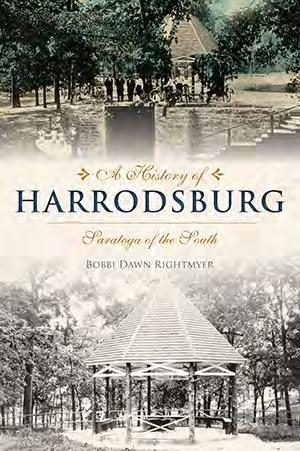
Western Kentucky has a reputation for its Southern hospitality, but throughout history, the region has been home to some bad characters, too. For proof, look no further than Richard Parker’s Wicked Western Kentucky Vice president of the Jackson Purchase Historical Society, Parker shares accounts of less-than-noble human activities in this wellresearched offering. From frontierera murderers Micajah and Wiley Harpe, whom many criminologists call “America’s first documented serial killers,” to the 1990s’ Rod Ferrell, the founder of a cult whose members drank each other’s blood and sacrificed animals, the author paints portraits of the worst examples of human nature.
Evidence shows that the James brothers, Jesse and Frank, played parts in bank robberies in Russellville, and “Buckskin Bill’s Wild West Show” in Paducah was more than wholesome family fun. Readers might not realize that the illegal moonshine business did as well in the western part of the state as it did in the east. In sharing the history of the Night Riders, a racist vigilante group purportedly fighting for the rights of the region’s tobacco farmers, Parker demonstrates how noble causes can turn corrupt with the wrong kind of leadership.
By Steve FlairtyWicked Western Kentucky, by Richard Parker, The History Press, $21.99 (P)
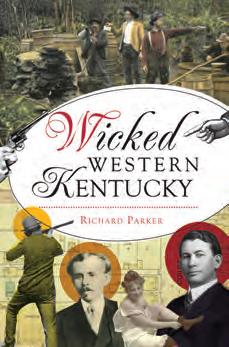



Get ready for gardening season with this down-home collection of practical advice and personal anecdotes from Kentucky Monthly’s gardening columnist, Walt Reichert. Organized by the seasons, each chapter offers color photography and straightforward tips for everything from combating critters to pairing plants.

The Bluegrass State’s green thumbs have proliferated, thanks to Walt’s encouraging and down-to-earth morsels of gardening wisdom.
Horticulture meets humor in gardening columnist Walt Reichert’s collection.
shopkentuckymonthly.com 888-329-0053

o o o o o
To order: kentuckymonthly.com 1-888-329-0053
My friend Duane Bolin died a few months ago. His death, at age 66, was stunningly unexpected and left a deep void in the lives of those close to him.

For several years, Duane wrote a syndicated weekly newspaper column, eventually gathering a collection of these popular columns into a book, Home and Away: A Professor’s Journal He afforded me the honor of writing the book’s foreword, in which I referred to the author, accurately, as “a Renaissance Man.” A modest man, Duane found this description slightly discomforting. He asked that I change it. I refused, our agreement having been that the twopage foreword would be mine to say as I pleased and was to be accepted or rejected in whole. Duane, of course, stuck by our agreement. He was a man of his word.
Duane Bolin was many things: husband, father, Christian, historian, professor, author, runner, writer, reader, scholar, columnist, mentor, traveler, friend, Kentuckian.
He was not, however, much of a fisherman, although he once expressed a wish to be, writing in a Home and Away column of a secret dream to “wade out into the waters of Casey Creek in Trigg County, an exotic bamboo fly rod in hand, casting out in perfect rhythm a fly tied with my own expert hands.”
To my knowledge, he never tied or attempted to tie a Caddis, Adams, Wooly Bugger, Royal Wulff, Hare’s Ear, Prince Nymph or any other fly.
We did, however, fish together once, not at the aforementioned Casey Creek but on Arkansas’ Spring River.
Duane wore borrowed waders and wielded an 8-foot bamboo fly rod compliments of rod builder, mutual friend and fellow Kentuckian John Durbin. We began the day about a
mile downstream from Mammoth Spring, which fuels the Spring River and, on average, pumps out about 9 million gallons of 58-degree water every hour, giving it claim to the seventh-largest freshwater spring on the planet. Duane asked if we could stop and see it before getting on the river—a request to which I readily agreed. The spring is part of a state park, but the spring site is surprisingly placid and likely a disappointment to some visitors. The actual spring is about 80 feet deep and appears as a shimmering, sometimes opaque 10-acre pond. Duane enjoyed it.
We followed the river downstream to a popular wade-in fishing access that opens to a wide, shallow section of the river marked by countless basketball- to bathtub-size boulders and rife with trout-holding seam water. It is a long stretch that eventually pools above Dam 3. There is a small century-old powergeneration dam (now inoperative) near the spring. Dam 2, lost to a flood decades ago, stood about 200 yards below the fishing access.
We pulled on waders and strung up the bamboo rod.
“Are you not going to fish?” Duane asked, a slight rise of panic in his voice.
“I’ll fish later,” I said. “I thought I’d try guiding for a little while first.”
We walked upstream to a spot I
knew would require no more than ankle-deep wading.
We reached the water’s edge. Duane stopped and surveyed the river. At this spot the Spring is about 60 yards wide, the water shallow but broken, moving in dark troughs, and dancing riffles for more than a quarter mile. It’s productive water but must be waded with caution. There is also plenty of water that can be fished from shore.
We waded out carefully. I directed us to the lip of a gravel patch—firm footing with a nice piece of seam water within easy reach. Duane opened a fly box.
“Which one?” he asked.
“This one,” I said, a No. 12 black bead head wooly bugger.
He plucked from the box and tied it on. He stripped off a few feet of line and whipped the rod. The fly landed hard near the edge of the seam water—not perfect rhythm but perfect enough. A fish struck hard on the second cast and darted downstream. The battle was violent but brief. The line fell limp.
Duane was crestfallen and apologetic, neither of which was necessary.
“I lose fish all the time,” I said. “But next time, maybe it’d be best not to set the hook quite so hard.”
The next time came a few casts later. A 12-inch colorful rainbow that splashed enthusiastically but didn’t jump. Reaching clumsily, I lost it at the net. It was my turn to be crestfallen and apologetic. Duane patted me on the shoulder, saying nothing.
We fished slowly, working our way downstream along the grassy bank. An hour passed with no action. Then fish struck on back-to-back casts. Duane missed the hookset on both.
“It just takes a little practice,” I said.
Fly fishing is not difficult, but efficiency generally comes with
practice. Duane’s experience rested in the literary realm with master anglers Maclean, Lyons, Hemingway and McGuane




We waded out to one of the deepest pools in this stretch of the river. I suggested that Duane feed the line out slowly and allow the fly to sink and drift in the current. Not exactly the technique of A River Runs Through It but practical and effective. A heavy fish struck near the end of the third drift. The trout came to hand—about 14 inches and thickbodied but with pale coloring. A recent stocker, I thought. The fish was strong but offered little fight. This time, I did not miss with the net.
Lunch at a local spot favored by visiting fishermen was followed by an afternoon of fishing and sightseeing. I did most of the fishing; Duane, a book nearby, did most of the sightseeing. A pleasant day.
Festival of Lights, Patti's 1880s Settlement, Grand Rivers, through Jan. 31, 270.362.0152
Christmas Spectacular, presented by the Louisville Chorus, Galt House East, Louisville, 502.968.6300
Holiday Legends, Lights and Lore Louisville Youth Orchestra, Center for the Performing Arts, 502.584.7777
David Phelps: It Must Be Christmas, Paramount Arts Center, Ashland, 606.324.0007
Woodsongs Presents Tom Wopat, Lyric Theatre and Cultural Arts Center, Lexington, 859.252.8888
Nutcracker: The Magic of Christmas, SKyPAC, Bowling Green, 270.904.1880

Zach Williams –I Don’t Want Christmas to End Tour Corbin Arena, 606.258.2020
Beetlejuice: The Musical, Carson Center, Paducah, 270.908.2037
A Christmas Carol, Spotlight Playhouse, Berea, through Dec. 4, 859.661.0600
The Best Christmas Pageant Ever, Campbellsville University, Campbellsville, 270.789.5266
A Celtic Family Christmas Norton Center for the Arts, Danville, 859.236.4692
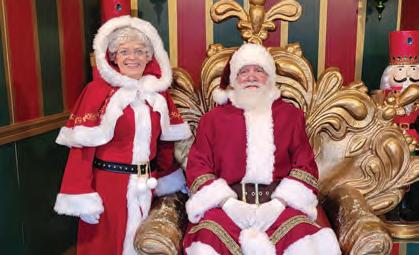
Dickens Christmas Festival, Kentucky Renaissance Fair, Eminence, also Dec. 4, 10 and 11, 502.845.9206

Kentucky Opry Christmas Mountain Arts Center, Prestonsburg, 606.886.2623
Jimmy Fortune Christmas Show, Bluegrass Music Hall of Fame, Owensboro, 270.926.7891
MCC Singers Community Christmas, Glema Mahr Center for the Arts, Madisonville, 270.821.2787
Christmas Spectacular presented by Orchestra Kentucky, SKyPAC, Bowling Green, 270.904.1880
Mannheim Steamroller Kentucky Center for the Performing Arts, Louisville, 502.584.7777
Shen Yun, Kentucky Center for the Performing Arts, Louisville, 502.584.7777
RiverPark Center, Owensboro, 270.687.2770
Disney’s Winnie the Pooh Live Stage Show Carson Center, Paducah, 270.908.2037
PBR: Pendleton Whisky Velocity Tour, Rupp Arena, Lexington, through Jan. 7, 859.233.4567



Carol Burnett Show, Barn Lot Theater, Edmonton, 270.432.2276
Camp Musical, Spotlight Playhouse, Berea, through Jan. 15, 859.661.0600
Herman’s Hermits Starring Peter Noone, Glema Mahr Center for the Arts, Madisonville, 270.821.2787
Singin’ in the Rain, Carnegie Visual and Performing Arts, Covington, through Feb. 12, 859.957.1940
Iclearly remember the New Year’s night our neighbors, the infamous Silvernails, invited us for a bonfire in their front yard. It was one of those difficult years we all have. We—their friends and neighbors—were asked to write down our regrets, disappointments and failures. We crumpled up our lists at an appointed time and threw them into the fire. It’s been a decade since that night, which, as I said, I clearly remember, but for the life of me, I can’t think of a single thing on the well-crafted list.
In the middle of To Kill a Mockingbird, Miss Maudie’s house is destroyed by fire. The divided community comes together to help Atticus’ neighbor retrieve most of her furniture, and Scout wakes up the following day with a blanket wrapped around her once-shivering shoulders by the mysterious, seldom-seen Boo Radley. The fire so engrosses Jem and Scout that neither of them sees Boo, who they’ve spent the summer and fall fictionalizing.
The point: Fires bring us together.
Whenever we have a fire going on our deck, which is at least once a week, our neighbors know they’re invited.
This year’s fire pit highlight was a gathering of old friends at Dan and Julie Schmalz’s backyard in southwestern Jefferson County. Dan’s fire pit is a large wheel rim surrounded by railroad ties and numerous logs for barbecuing and burning. Why a retired firefighter enjoys fire is a question for local psychiatrists, but a dozen childhood friends shared laughs as a full moon and Jupiter hung high in the eastern sky. I’ll long remember passing myself off to one classmate as another who was not in attendance. “I always get confused,” Carl, one such friend, asked. “Are you Steve Vest or Wayne Tichenor?”
“Me?” I responded. “I’m Tish. We invite that Vest guy to stuff, but he’s a jerk, and we’re glad when he doesn’t show up.”
were in old Troop 124. Nearly 50 years ago, Blazing Saddles’ satirical depictions of racism, written chiefly by comedian Richard Pryor, were over our heads. Still, firefighterturned-actor Burton Gilliam and the other cowboys passing gas around a campfire left us in stitches.
My childhood tale includes a barn fire in Verona, my dad’s hometown. The barn was near my Uncle Charles and Aunt Virginia’s house. We found footprints in the mud leading away from the fire and were sure that if we followed the trail, we’d find the culprit. We only needed an angry mob and a few hound dogs, which we didn’t have, and a shotgun, which we didn’t own.
The first newspaper I worked for was the McLean County News. My time there is bookmarked by a bonfire honoring the first winning football team in school history and the suspicious Livermore Furniture Factory fire that drew gawkers from several counties.
STEPHEN M. VEST Publisher + Editor-in-Chief
Without a nod or wink, everyone else around the fire went along with the gag. By the end of the evening, I was getting used to being called Tish and started to form negative feelings toward the absent Vest fellow. Come to think of it, he is a jerk.

When I think of Camp Covered Bridge in Prospect (where I went to Scout camp) or church camp in North Carolina, I remember times around a fire.
Name a good Western that doesn’t have one, including Blazing Saddles, released when I was in middle school and Johnny and Donnie Gosser, allies in the Tish gag, and I
Man’s first use of a fire pit dates to the Middle Paleolithic period, some 40,000 to 250,000 years ago. Archaeological evidence in the Tabun Cave in Israel’s Mount Carmel and the Klasies River Caves in South Africa shows fire pits made using a collection of stones. After repeated usage, ash built up, creating the underpinnings of what we know as a hearth.
Many cultures used a hole in the ground filled with hot coals and stones for warmth and cooking. Peruvians, Eastern Indians and many Polynesian cultures used fire pits to cook during festivals, harvests and religious ceremonies. Native Americans used fire pits in teepees for heating and council discussions.
We all have pleasant fireside memories. It’s about the people we’re with, the conversations and laughs we share, regardless of whether the details stay with us or drift off in the smoke. Either is fine. If you don’t believe me, ask Tish.
Kwiz Answers: 1. C. The Haynes Sisters escape from a Miami nightclub while Bing Crosby and Danny Kaye parody their hallmark song “Sisters”; 2. A. Louisville native Niles wrote in his unpublished autobiography that the song “grew out of three lines of music sung for me by a girl who called herself Annie Morgan” in Murphy, North Carolina; 3. B. The Whitley County native had been honored with the 1964 Academy Award for Best Actress for her role in Hud opposite Paul Newman; 4. C. A Freelance writer, composer, and musician Stephen Lyon graduated from the Danville school with a bachelor’s degree; 5. B. Covington recognized the composer and lyricist by naming a boulevard for him and placing a historical marker in his honor; 6. A. The rural town about 50 miles northeast of Louisville is one of around a dozen towns in the United States with the name; 7. B. Sponsored by the U.S. government, the Fulbright Scholarship is awarded to more than 800 individuals each year; 8. C. The railroad was used to transport food and other supplies from Louisville to the Union Army’s depot in Nashville; 9. C. His appearance as Gangster Johnny in the sequel, Home Alone 2: Lost in New York, was his last film credit. Foody is best remembered as the police dispatcher in the 1980 film classic The Blues Brothers; 10. B. Varney voiced the role of Slinky Dog alongside fellow Kentuckian Annie Potts as Bo Peep.
We come from all across Kentucky to The Gatton Academy on the campus of Western Kentucky University. As juniors and seniors in high school, we enroll in WKU courses, conduct research with WKU professors, and study abroad. While we are challenged academically, we thrive in a supportive environment designed just for us and make lifelong friends. Best yet, our tuition, meals, housing, and fees are all paid for by the Commonwealth of Kentucky. You, too, can have a future filled with infinite possibilities.

At the heart of America’s inland waterways, you’ll find a sophisticated rivertown that inspires. Paducah, Kentucky, is a confluence of cultural heritage and creativity where art goes beyond something to appreciate – it’s a way of life.


A designated UNESCO Creative City, Paducah is gaining acclaim as a destination for those who crave rich, authentic cultural experiences!

Immerse yourself in the artistry and technique of masterpieces from around the globe at the National Quilt Museum. Plan your experience at Paducah.travel
1-800-PADUCAH